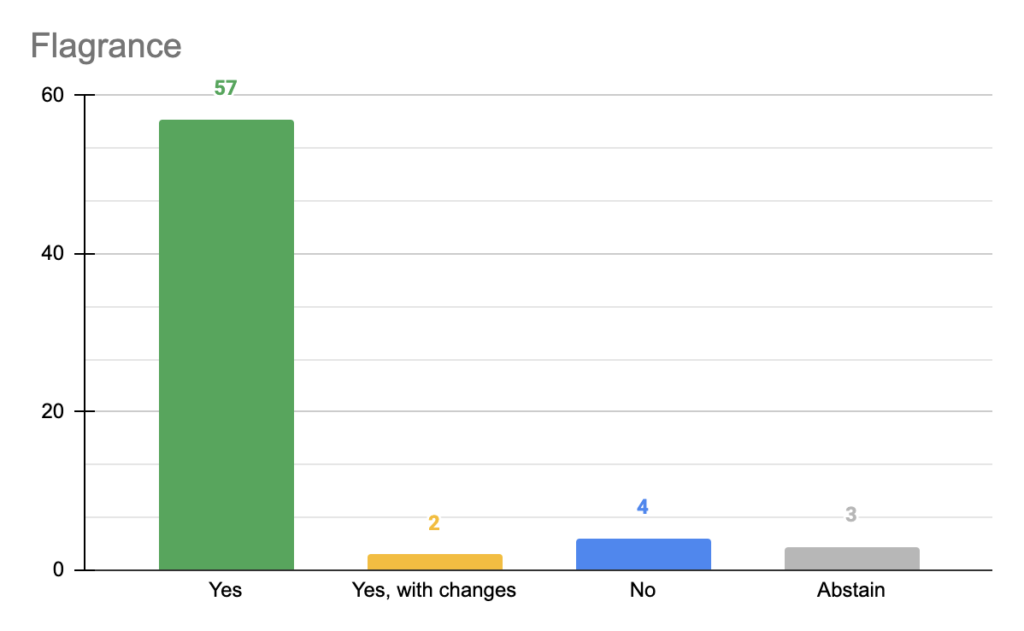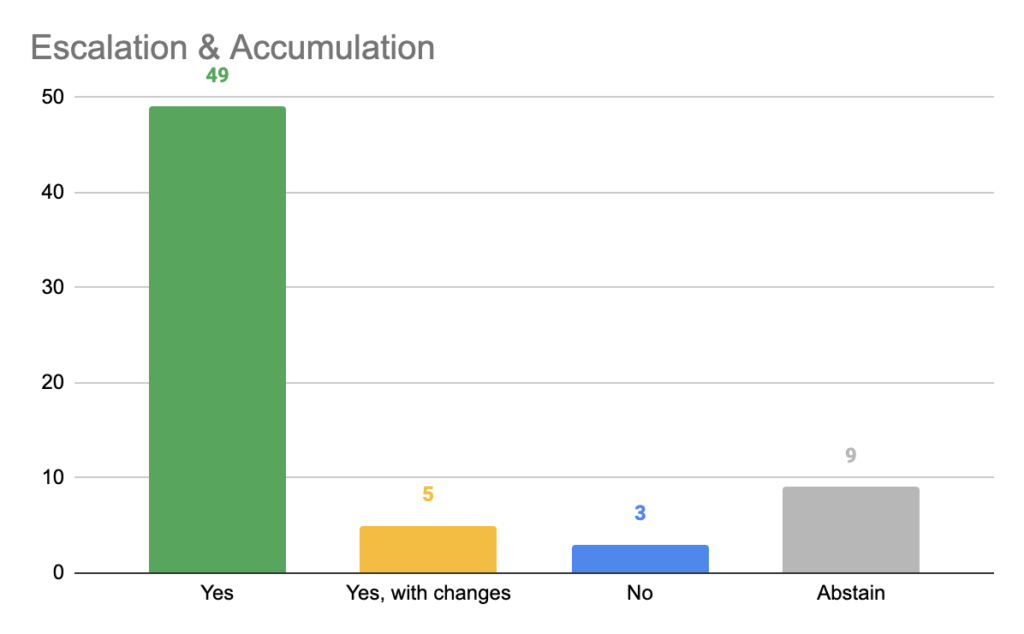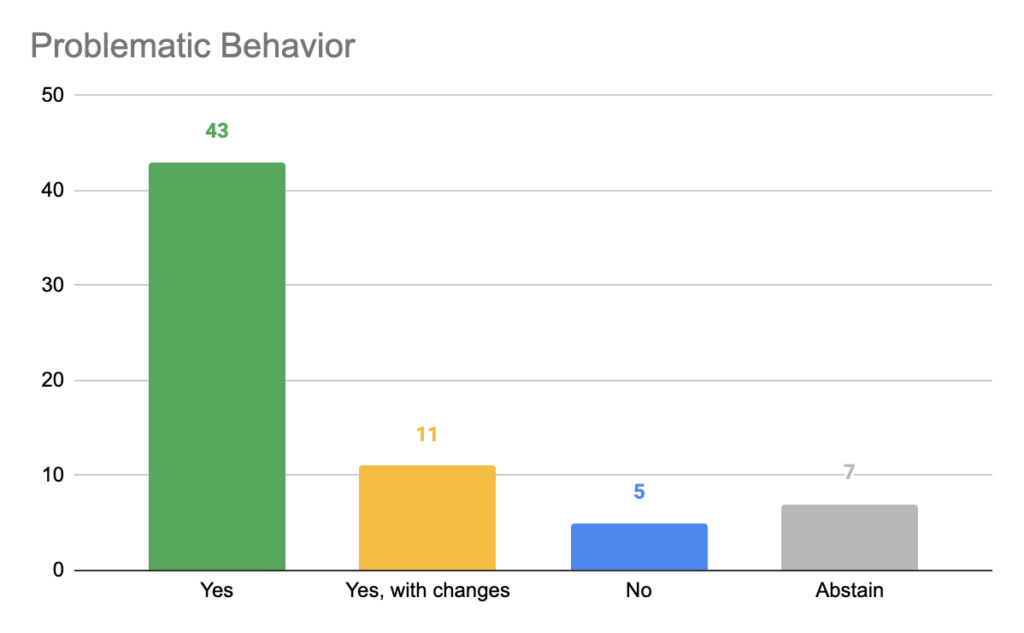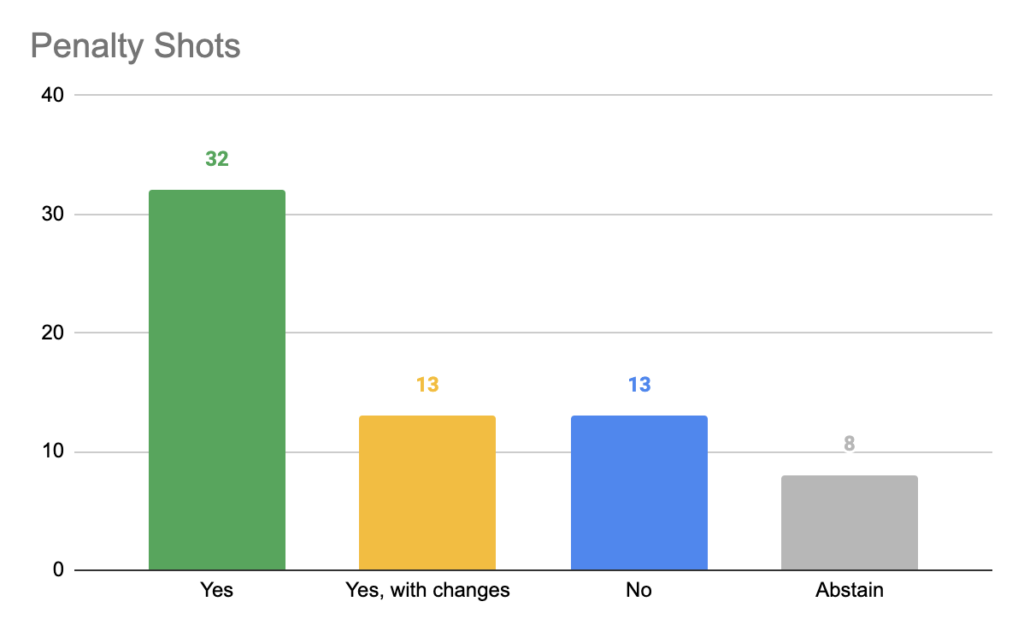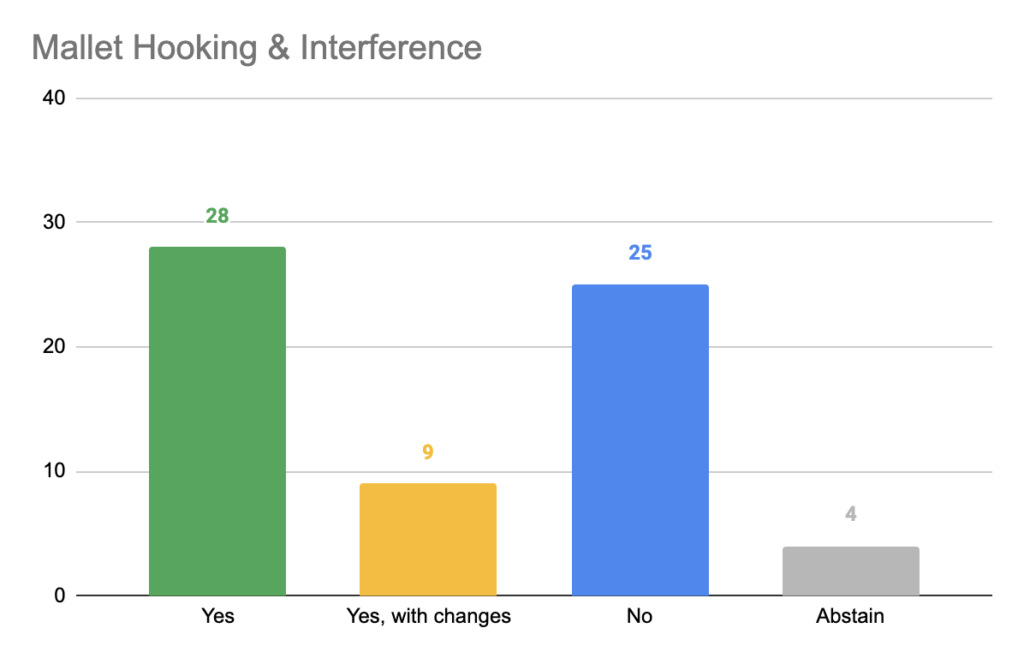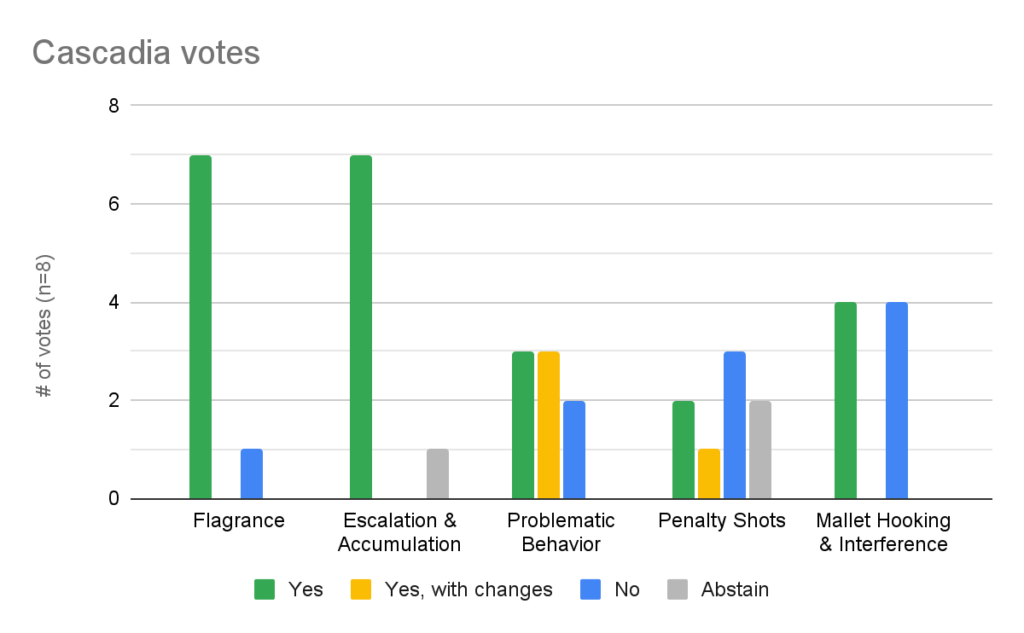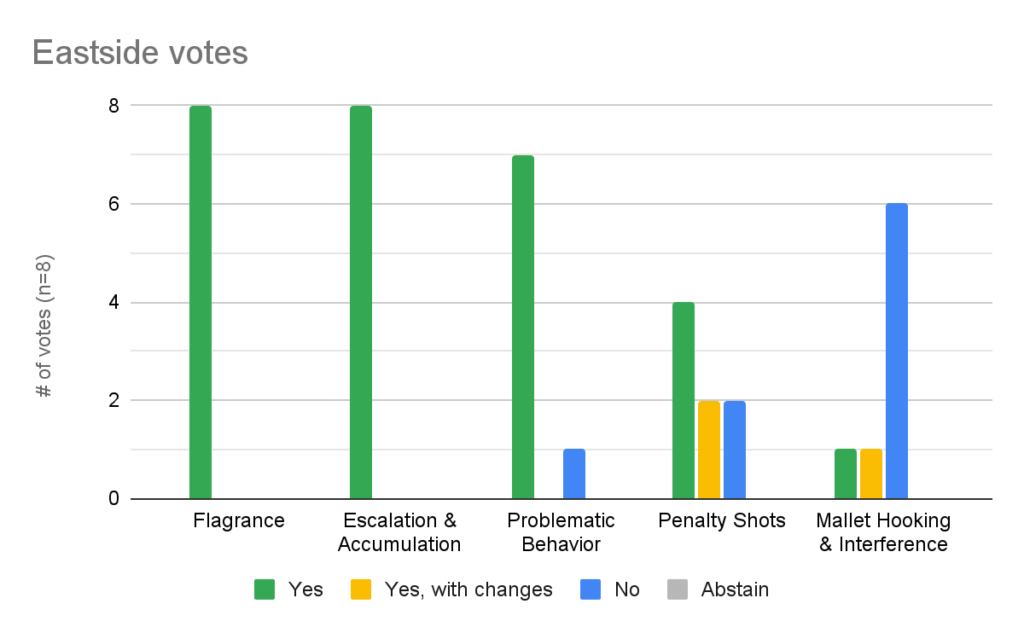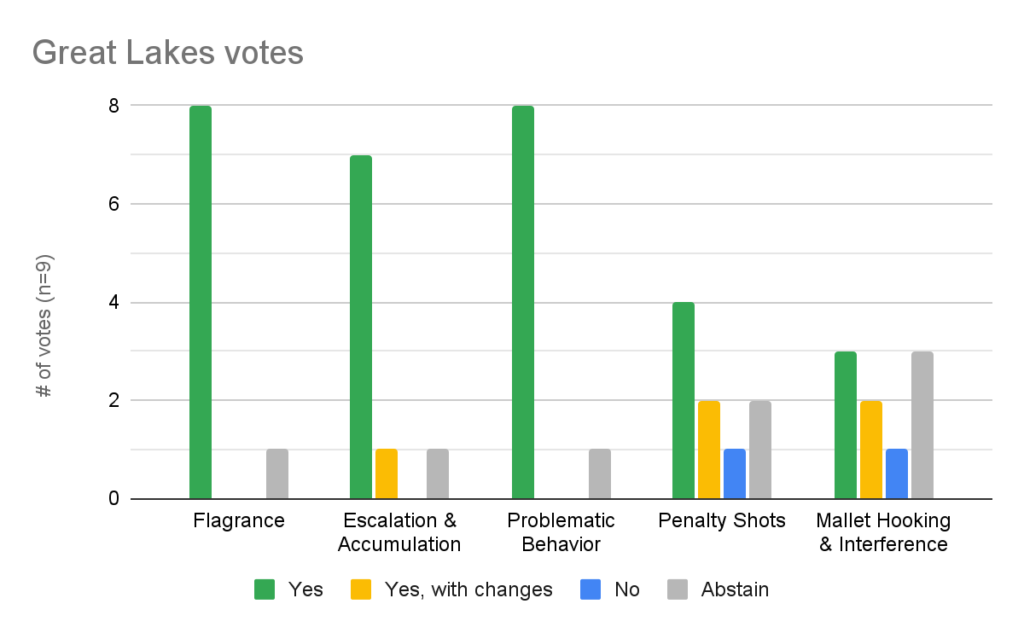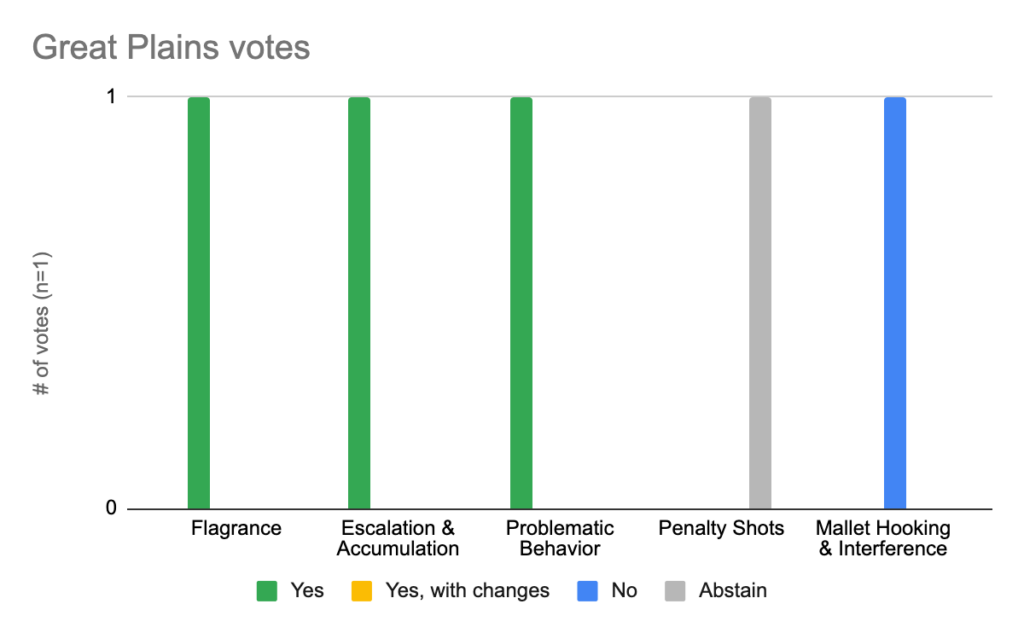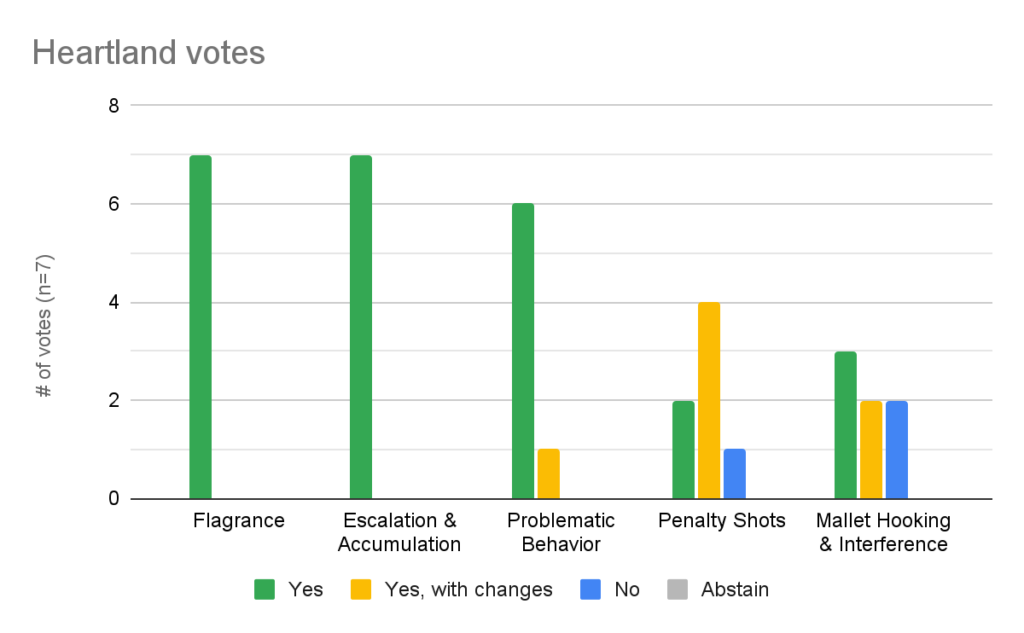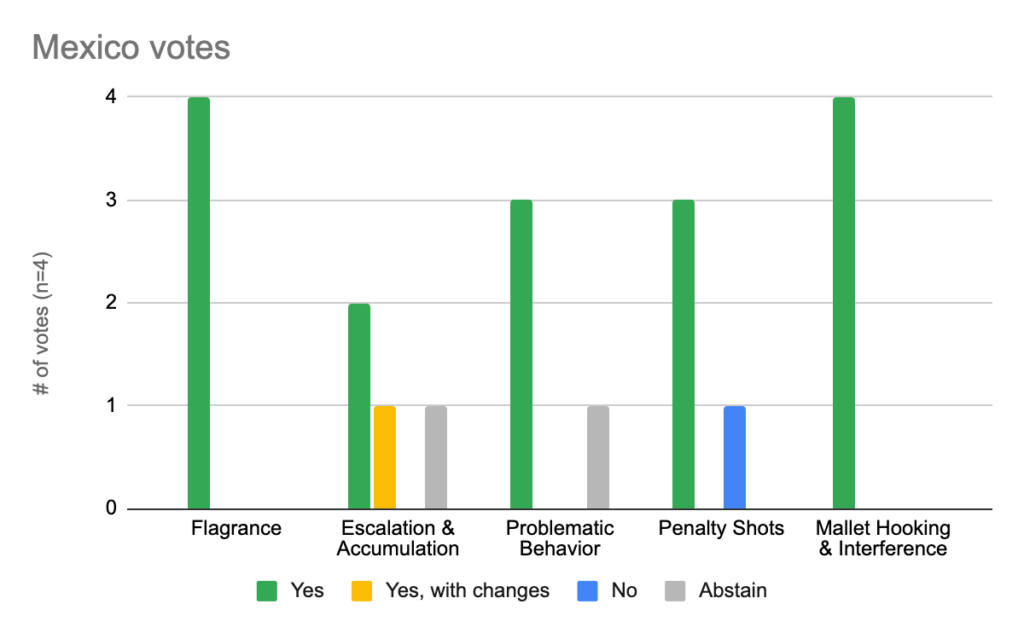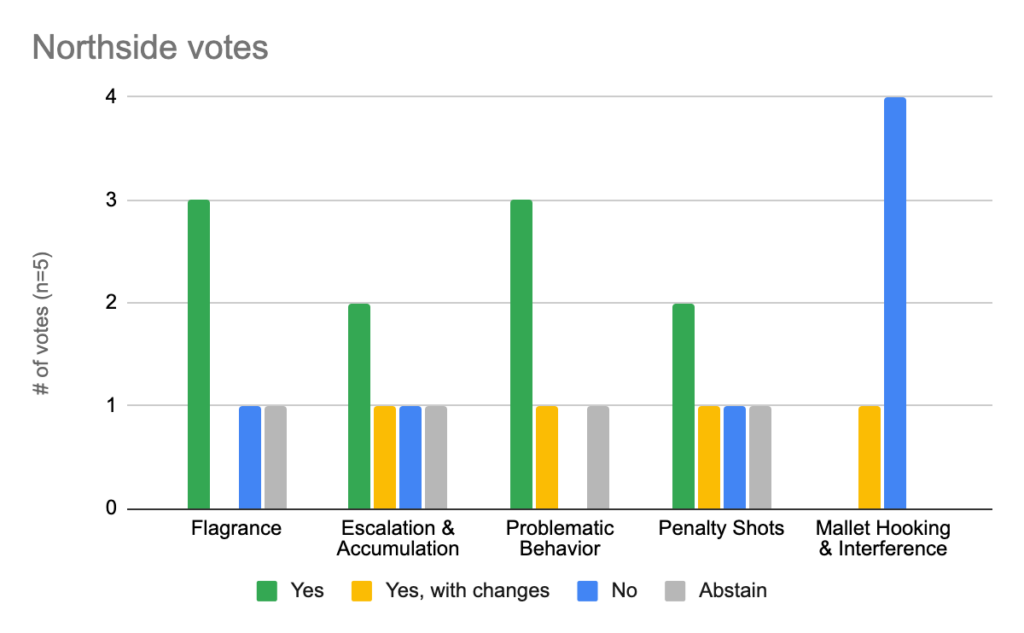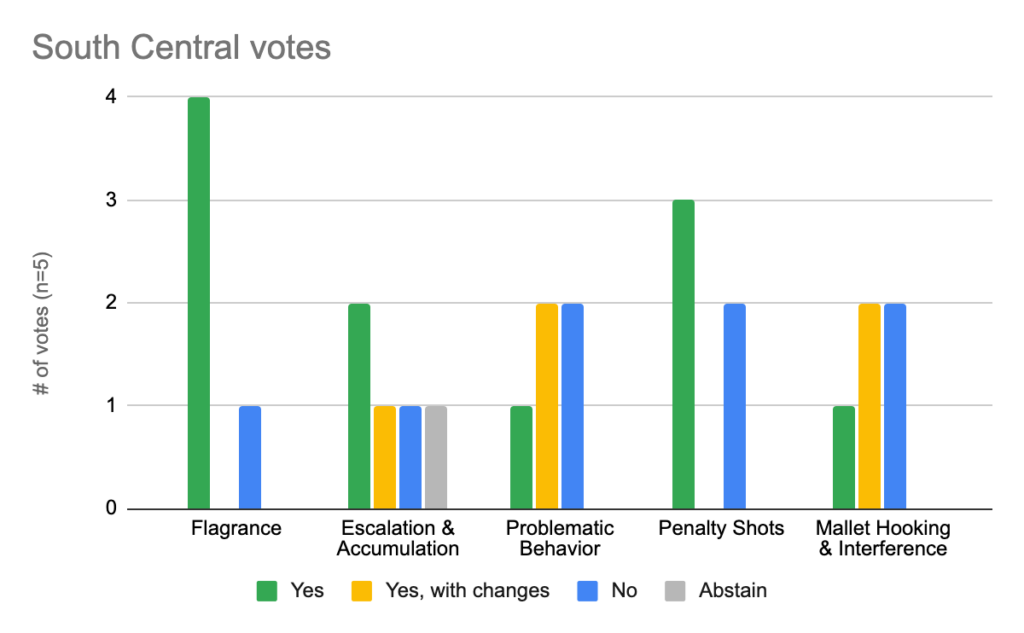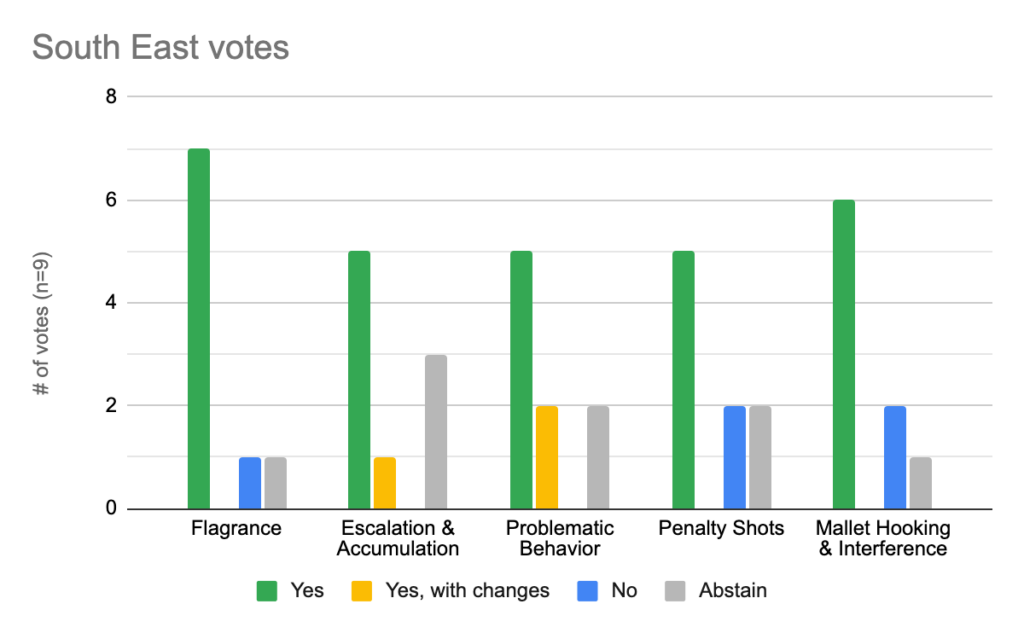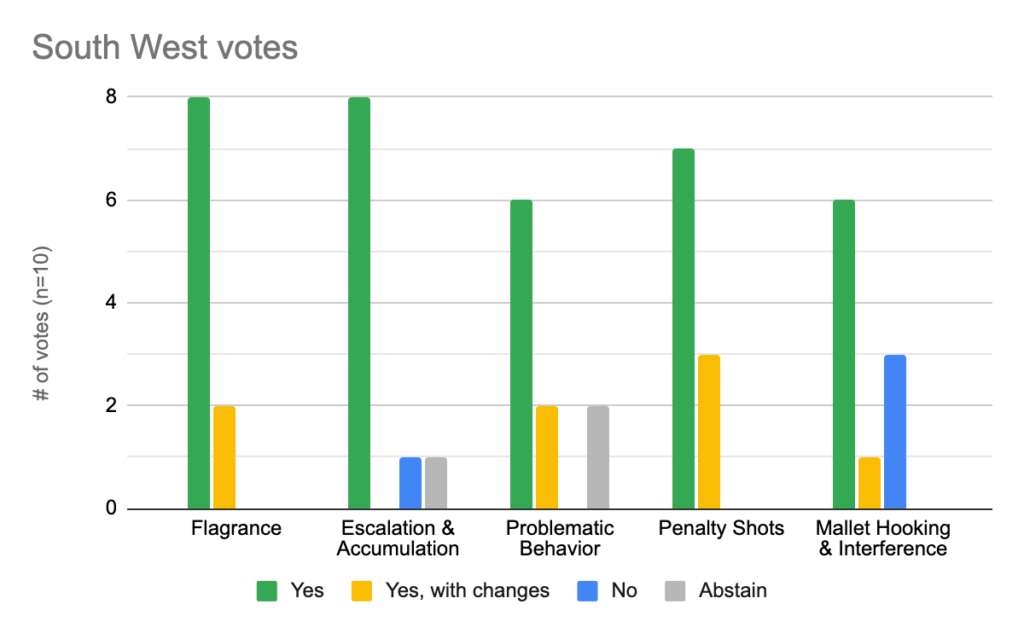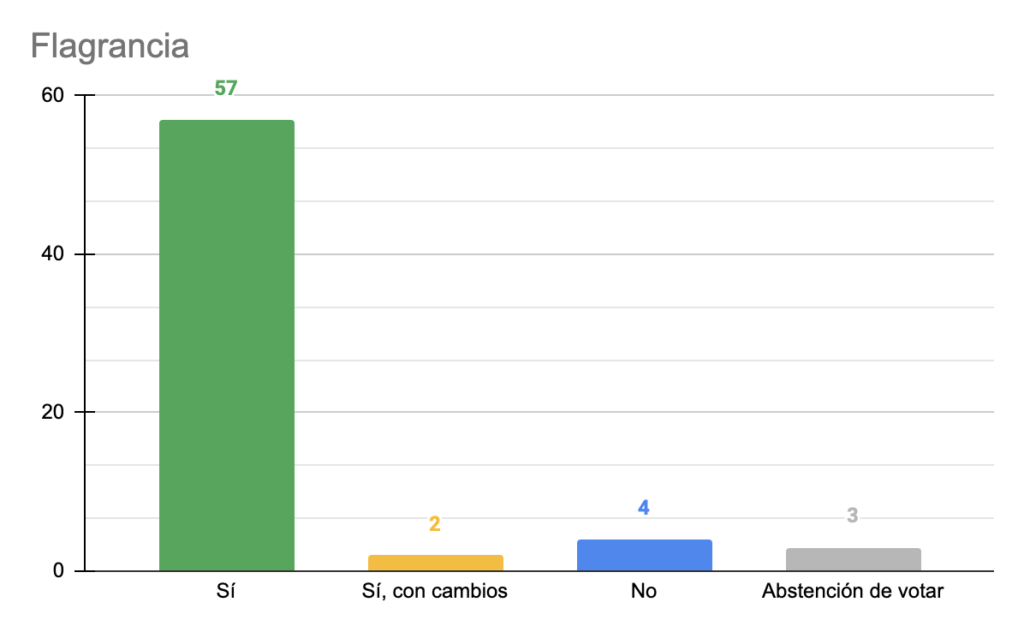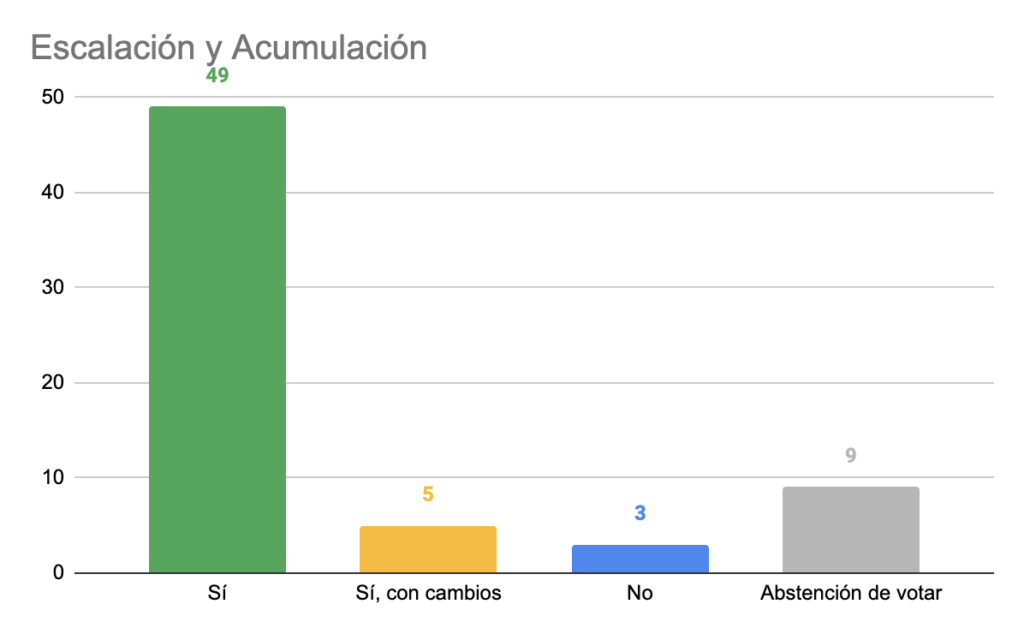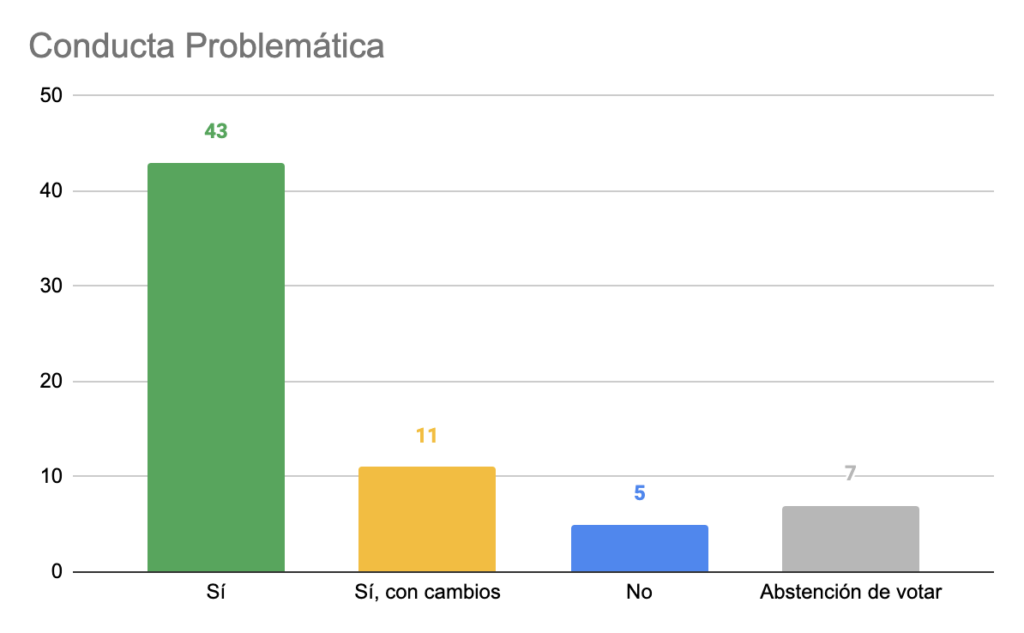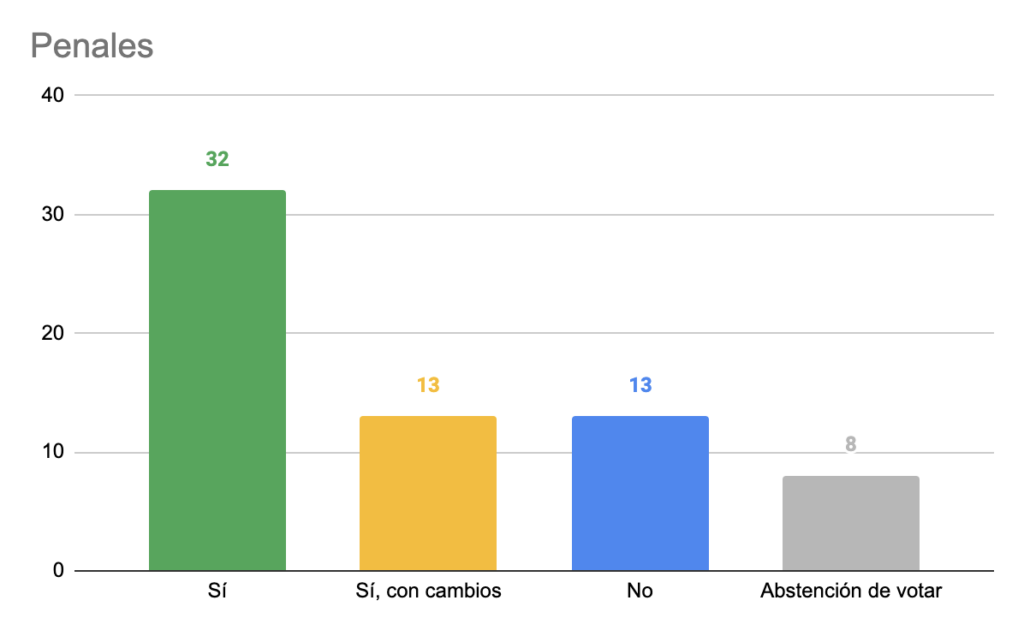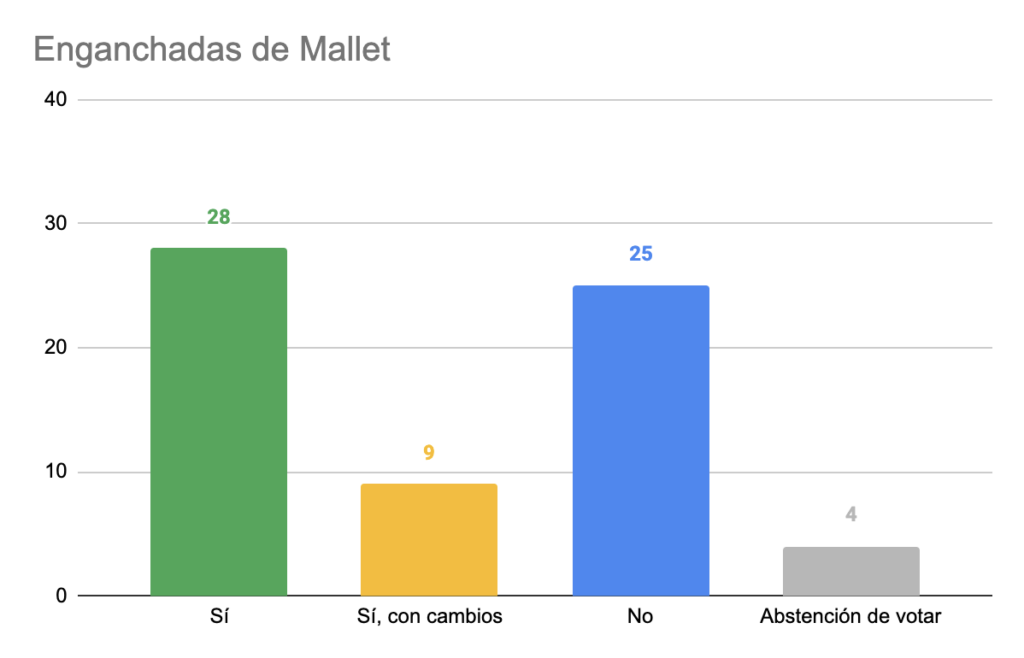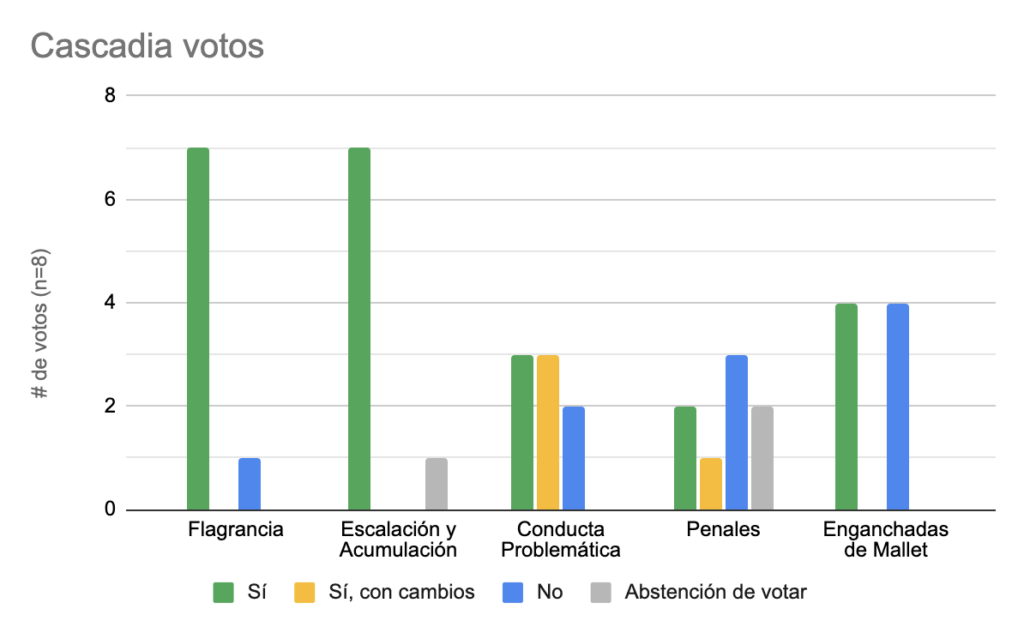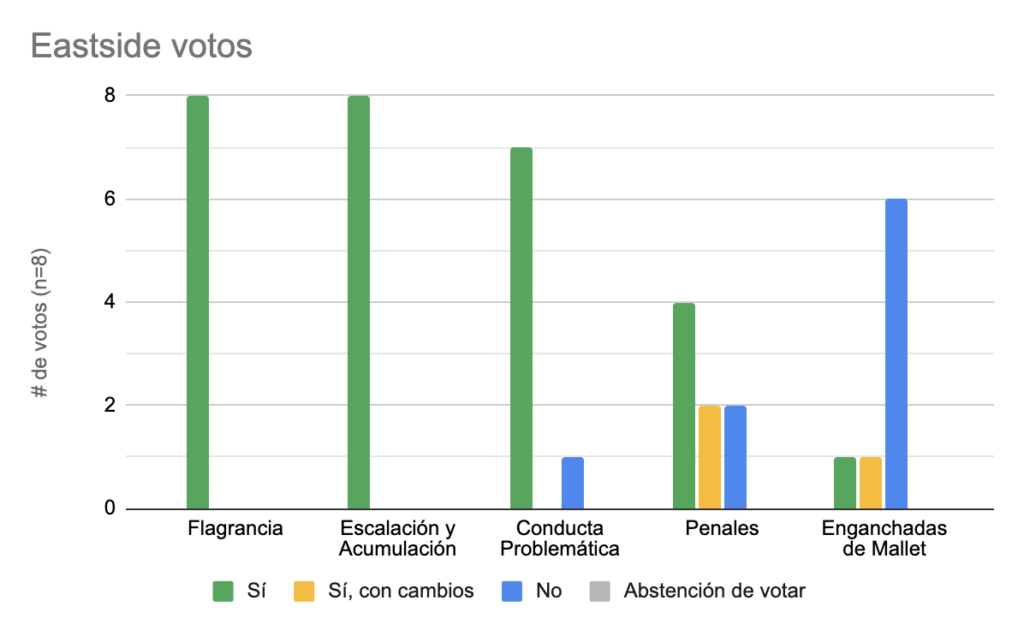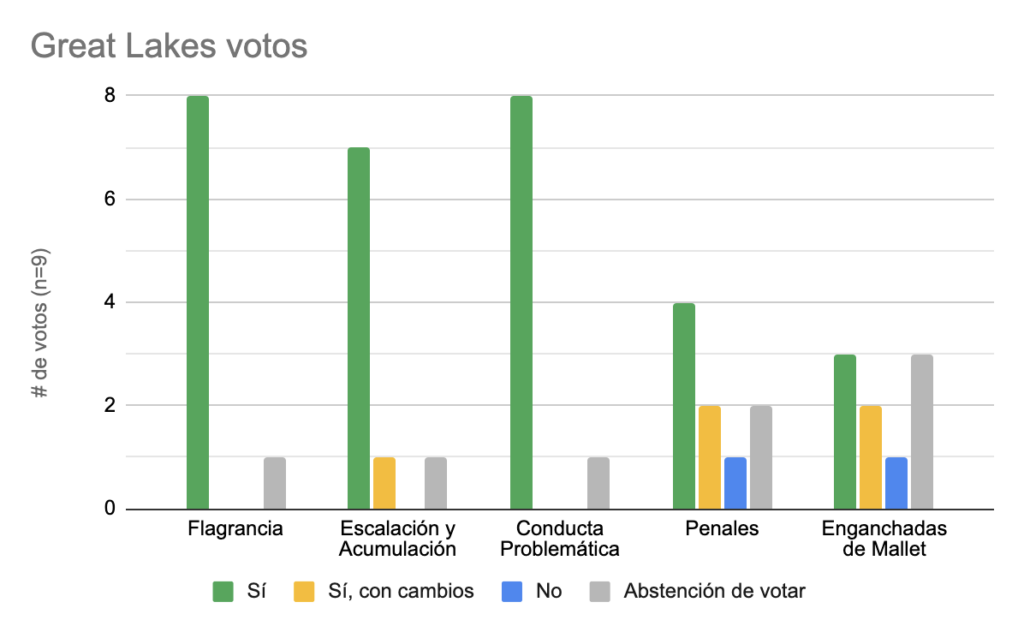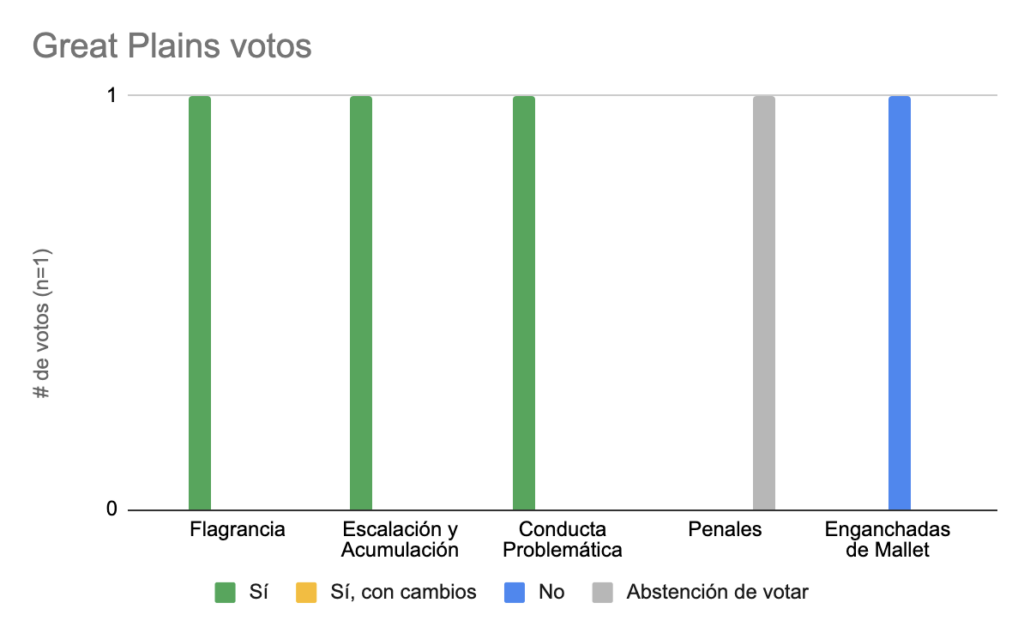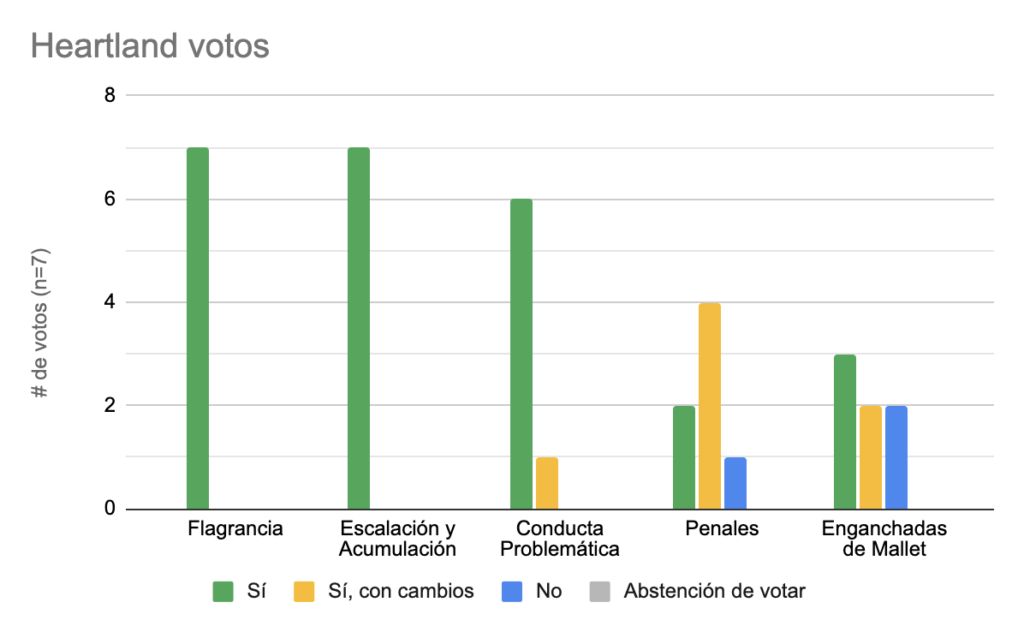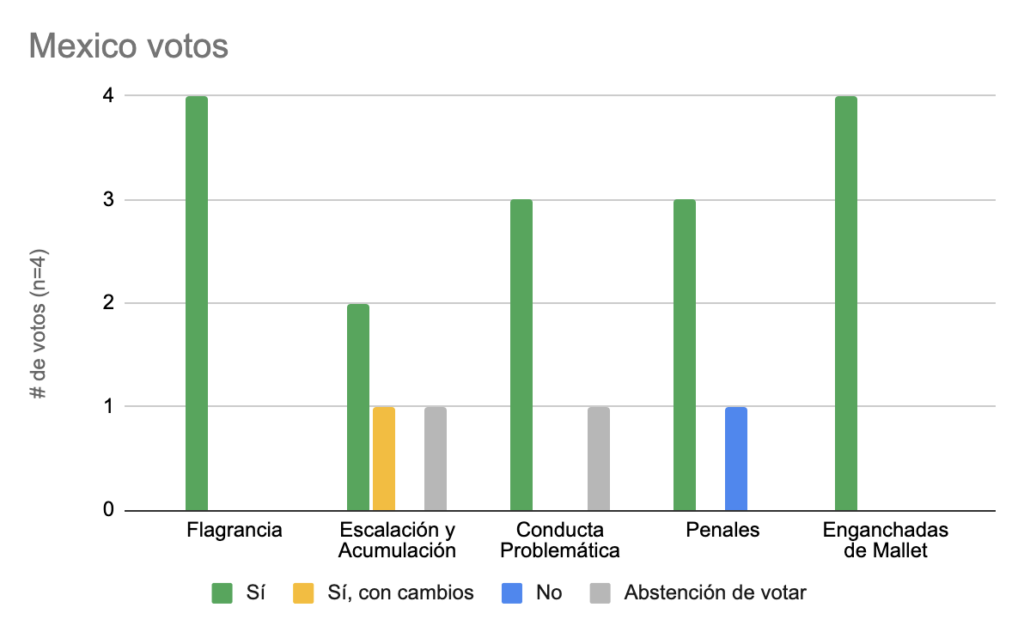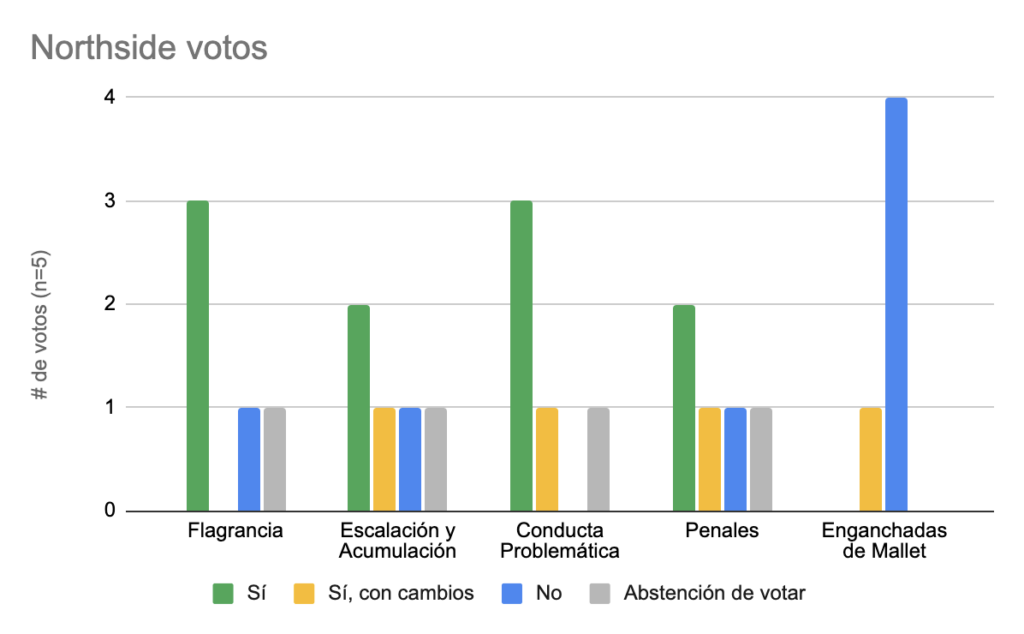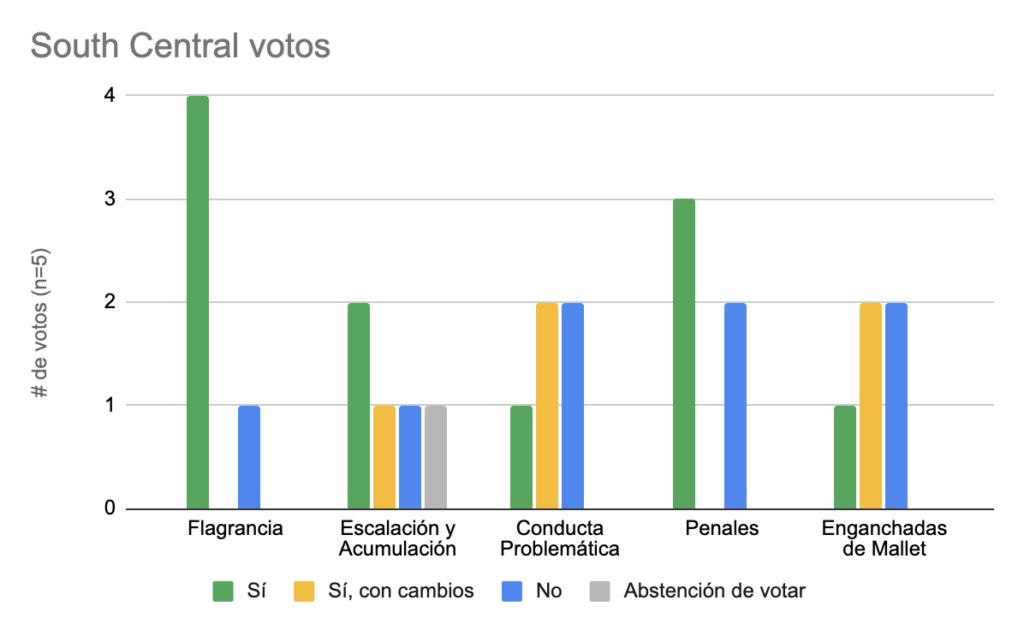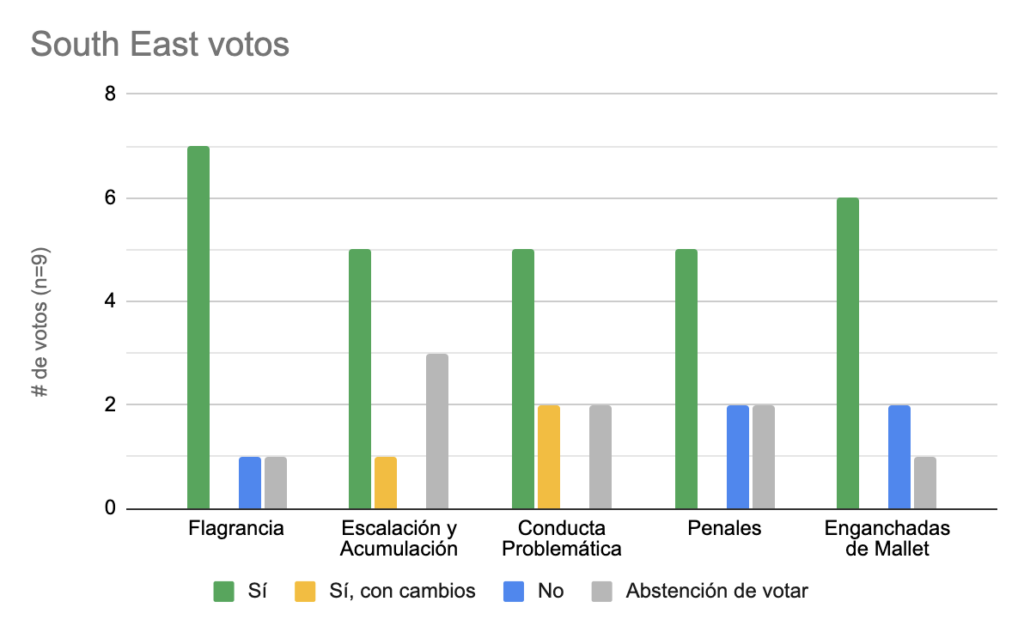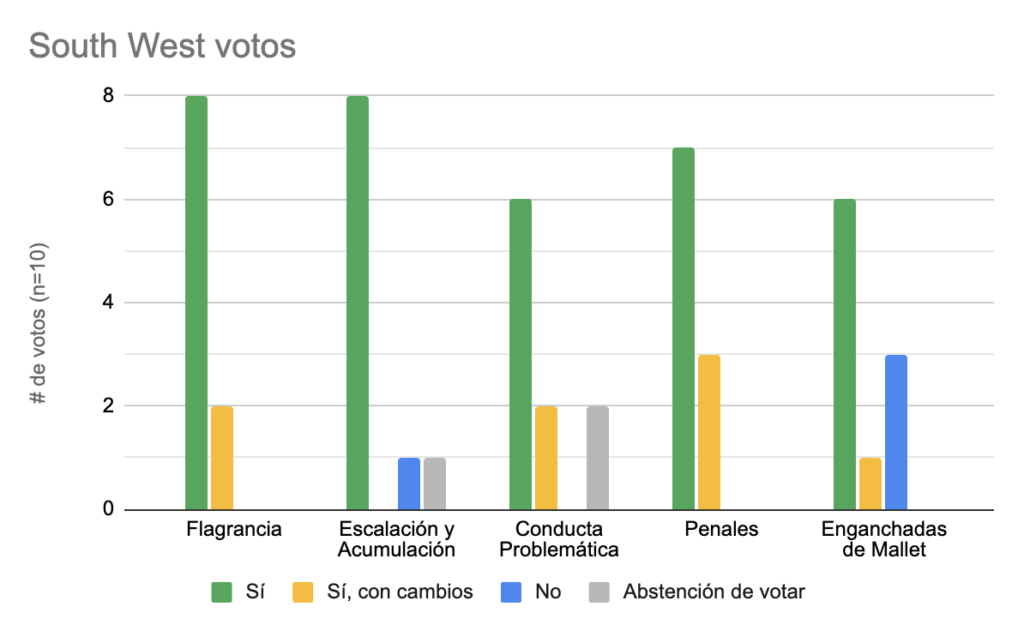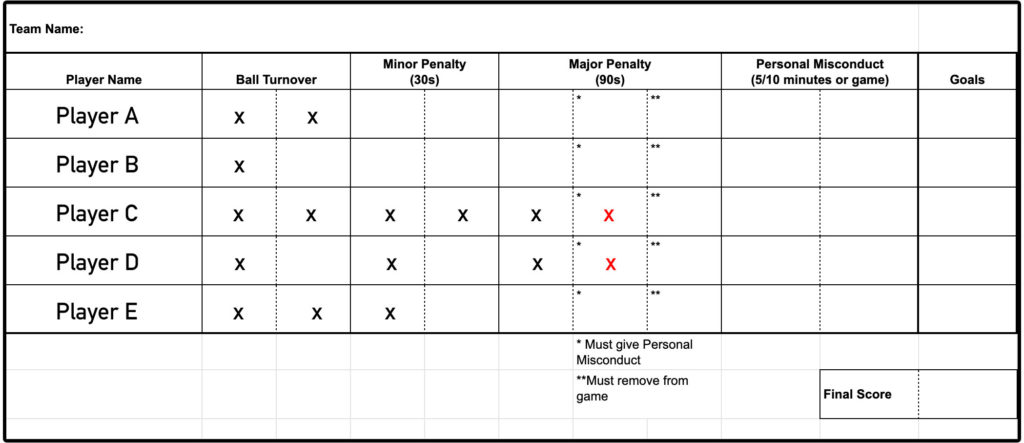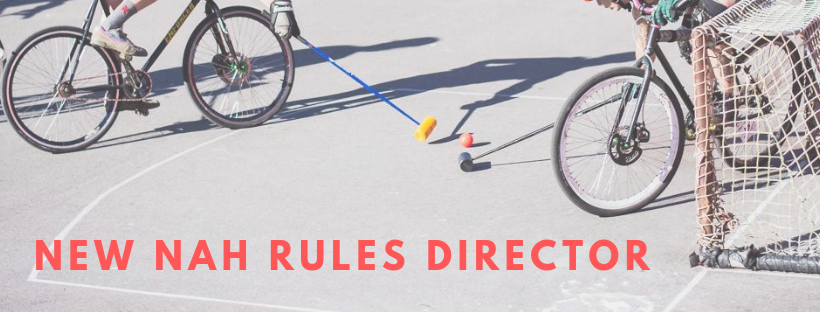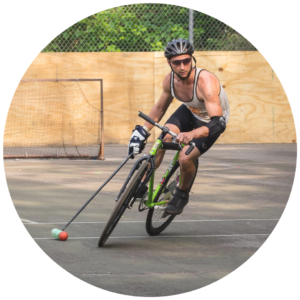***We are extending the voting period by 2 weeks to allow updates to be published prior to clubs voting, and to give every region a chance to discuss and ask questions***
We are happy to announce that we have developed and are proposing a variety of rule changes for the 2022/2023 NAH Championship season, and we hope to gather feedback and answer questions throughout this month so that we can successfully implement these updates. This post includes:
- An overview of how and why NAH considers and develops new rules.
- How you and your club can contribute to the proposed rule changes.
- A list of proposed rule changes along with the current rule, for easier comparison.
- An introduction for each proposed rule change so you can understand the reasoning and context for suggested changes and updates.
The NAH Rule Development Process
Our objective is to continue making NAH tournaments safer (on and off the court) and a more fair competition of strategy and skill. The paradigm that we use to pursue rule changes is fairly simple and centers around the primary objective of the game: scoring more goals than your opponent in a certain amount of time. As a litmus test to use, we ask a variety of questions to determine which problems to solve, and whether those problems are related to player conduct, safety, strategy or procedure, and lastly, would a change to the rules serve the primary objective of the game. To that end, we’ve outlined below how this process will work and have provided explanations for each proposed rule change.
Purpose-driven Rulesets
We recognize that the NAH ruleset is utilized in most tournaments on the continent, and gets referenced by many clubs during pickup. To help with this, we are planning to release a more simplified version of the ruleset that is easier to explain to newer players and easier to implement in more casual tournaments and at pickup. This ruleset is intended to ensure that every game from the beginning of NAH Regional Qualifiers to the final game of the North American Championship is as fairly contested as possible, that the best team will win and that no one gets hurt unnecessarily. We do not want to prevent you and your club from playing their own style, or with their own rules, if you believe that it’s more fun or competitive or skillful; and we are always open to input regarding evolution of the game as it relates to the ruleset.
Play-Testing
The past few years have made it incredibly difficult to play-test some of these rules in high-level tournament play, but it has made it easier to spend more time revising, discussing and reflecting on these suggestions. We plan to play-test these proposals in a few upcoming tournaments and gather feedback from participants. That being said, most of these changes have been developed from observing years of late sunday tournament play at continental and world championships, and we’ve had players of all skill-levels and Referees providing feedback on these proposed rule changes.
Rescinding Rules
We are aware that NAH Regional Qualifiers are often the first place in which new rules truly get play-tested. There are no rules that are permanent, and if the proposed changes are voted into the ruleset, we will still gather feedback and are always willing to quickly make adjustments. This has happened with every update in the past and is normal. We are always developing rules by committee and that can mean undoing something if it’s not working.
Refereeing
A common refrain when new rules are proposed is that they may be “hard to Referee”. We feel this is an indirect argument that can be used against nearly any change to the ruleset and should only be considered last after safety and competitiveness. With that said, these changes are intended to make Refereeing easier, as you’ll read below. Moreover, rules are intended to deter players from doing the actions they restrict. This argument does not directly apply, because it assumes players will continue doing that action at the same rate they do in the status quo. The reality is that when a majority of players abide by a rule, it becomes much more obvious when someone is not abiding by that rule.
Lastly, our intention is to remove as much gray area as possible from the interpretation of the rules and we encourage everyone to watch other sports closely to see how Referees often get calls wrong at the highest level of every professional sport and that Referees are not there to be perfect, but rather to manage the game and maintain competitive equity. There will be opportunities in the future to educate players who are interested in becoming proficient Referees, in the form of Referee clinics and online content. If you would like to help develop either of these, please reach out to will@nahardcourt.com or joe@nahardcourt.com.
Voting Process: How You Can Get Involved
In professional sports leagues, the owners of teams serve as a board who democratically vote on rule changes. These changes are often developed in collaboration with representatives from the Referees and Players Associations of that sport. We do not have team owners, but what we do have are 10 NAH Regional Representatives who have volunteered to coordinate NAH business with clubs in your region. You should also have an NAH Club Representative or a committee in your club who can communicate with your Regional Representative. We want you to ask questions, and participate in voting, if you feel that these changes affect your club. You are also free to abstain.
Voting will be conducted over a 3 week period starting June 3, 2022 and concluding June 24nd, 2022. In the first 2 weeks, Regional Reps will be reaching out to Club Representatives to answer questions or gather feedback. During the final week of the voting period, we will gather votes from the list of Club Reps provided to us.
In this round of updates, each change can effectively be implemented separately, so we will vote on each rule proposal individually. Club Representatives can vote Yes, Yes with Changes, No, or Abstain. A non-response counts as a Yes vote. A form will be provided per-region that will collect all of the club votes. For a “Yes with Changes” vote, a text field will be provided for each rule. The voting results will be tabulated and published, along with the new Ruleset, after the voting has concluded.
We encourage you to have discussions first within your clubs – in a constructive way – so that you can hear a variety of perspectives before forming an opinion or reaching out to us or your Regional Representative.
Here are some questions to ask yourself and to discuss with your club:
- Will this new rule help align play closer with the sports objective; e.g. putting the ball in the net, making the sport safer, more skilled, improving ball movement and game flow?
- For the proposed rules that I/we don’t like: why? Is there some personal bias that’s influencing your opinion? Is it because you personally like doing it, or it’s what you know/are used to? For example, most people hated the Obstruction rule until we tried it for a while and realized it improved the flow of the game. Change is hard! So, setting aside your personal opinions and change aversion (yes, this is hard to do!), what’s best for the sport overall?
Once you’ve had time to discuss with your club, please reach out first to your NAH Regional Representatives with questions (link to contact info). You can also email joe@nahardcourt.com with any questions, but the response time may be longer.
Rules that require voting:
Flagrance
We have seen instances over the past few years where the ball carrier attempts to ride through a defender in such a way that they crash themselves out, but the defender does not dab. Currently, this would be a no-call, since the defender did not dab or fall, but the ball carrier who initiated contact DID crash. We feel that a competitive advantage can still be gained from playing this recklessly and this proposed change is intended to discourage it and require both offensive and defensive players to stay in control of their bikes at all times.
Moreover, there are instances where a legal check has been made and the player who was checked can ride away from it or just dab, without crashing. We still feel that a competitive advantage can be gained and potentially dangerous situations are unavoidable with the current wording of the rule. Players who are incredibly skilled on their bike may not receive the same calls from the Referee that would be assessed to them for making the same play, and we do not want to punish skill.
Many in the community would like intentional body contact to be eliminated entirely, and hopefully this change gets us closer to a pragmatic approach that ensures any application of body contact is utilized in a safe and strategic or tactical manner.
Existing Rules:
- §10.9 – Flagrance
- …
- §10.9.2 – A Flagrance penalty is assessed when a player initiates physical contact which results in a potentially dangerous crash or is otherwise initiated in a manner deemed dangerous by the Referee.
Proposed Change:
- §10.9 – Flagrance
- §10.9.1 – A Flagrance penalty is assessed when a player – including the ball carrier – initiating physical contact uses excessive force on an opponent who is defenseless, or if the player initiates physical contact legally but abandons any tactical or strategic application of force, or if the player initiating contact dabs or falls but does not cause the other player to dab or fall.
- §10.9.3 – A Flagrance penalty is assessed when a player – including the ball carrier – uses their elbow, forearm, or hand, to initiate contact with an opponent in a way deemed by the Referee to be lacking tactical or strategic application.
Penalty Escalation & Accumulation
We piloted a first draft of the penalty escalation rules for Squad format in 2019 and it was a bit cumbersome to track and was never utilized due to minor and major penalties not being assessed as often as anticipated. This change is an attempt to both simplify the enforcement, but also to ensure that players who commit penalties to win a game will incur consequences throughout the course of a tournament. Over the past few years, we’ve seen players receive multiple penalties in the quarter finals or semi finals of elim tournaments, and in other sports this would mean suspension from subsequent games. We are going to emulate that in order to discourage unfair play as a tactic to advance during elimination brackets or group play.
Additionally, we will be increasing the time of a Minor penalty from 30 seconds to 45 seconds, and 90 seconds to 120 seconds for a Major. It’s our opinion that a Ball Turnover simply isn’t an equitable assessment for most infractions that happen, especially when those infractions happen near goal. With this change, we will see an increase in box penalties being given and we hope that players and Referees will feel more comfortable with that. Historically, some of the best teams have been effective at the penalty kill and the increase in time and frequency should help to both deter fouling but also increase the amount of goals scored during a player advantage, which we believe is a positive thing for our tournaments.
Existing Rules:
- 6.1 – Severity of Infraction & Escalation
- 6.7 – Minor Penalty
- §6.7.1 – An infraction that prevents a clear scoring-opportunity, takes away a significant advantage from the fouled team, or any other infraction specified in §6 – §10, results in a 30–second Player Advantage penalty.
- …
- 6.8 – Major Penalty
- §6.8.1 – An infraction listed in §7 – §10 that the Referee deems to be excessively dangerous or reckless in nature, or if a player was already assessed a Minor penalty for a similar infraction, results in a 90-second Player Advantage penalty.
- …
Proposed Change:
- 6.1 – Severity of Infraction & Escalation
- §6.1.1 – It is the responsibility of the Referee to issue any infraction listed in §7 – §10 and assess the severity of the penalty so that the competitive advantage gained from the infraction is equitably nullified. To determine the appropriate level of penalty, the Referee will use the following factors:
- §6.1.1.1 – The area of the court in which the infraction occurred. The closer an offensive player is to their opponents net, or a defensive player is to their own net.
- §6.1.1.2 – Whether an offensive player is fouled while they have earned an open net breakaway or one-on-one situation with the defensive player in the crease.
- §6.1.1.3 – The degree to which the player is fouled based on speed and force, and the potential danger.
- §6.1.1.4 – The relevance of the infraction in the course of fair play or the impact of the infraction on the outcome of the game. The greater effect the infraction had on the developing play increases the severity of the assessed penalty.
-
- §6.1.2 – Escalation
- §6.1.2.1 – A player who commits any infraction from §7, §8, §9 and §10 that does not cause a player to fall or dab, or does not disrupt a scoring opportunity per §6.1.1, is given a maximum of 1 (one) Ball Turnover. Every infraction thereafter is to be assessed a Minor or Major penalty, and the referee can choose to skip a Ball Turnover penalty and immediately assess a Minor or Major penalty at their discretion.
- §6.1.2.2 – A player who commits any infraction from §7, §8, §9 and §10 that does cause a player to fall or dab, or does disrupt a scoring opportunity per §6.1.1, is immediately assessed a Minor or Major. All subsequent infractions are assessed a Minor or Major penalty at the discretion of the Referee.
- 6.2 – Foul Accumulation
- §6.2.1 – Individual Accumulation
- §6.2.1.1 – A player who has been assessed 1 (one) Ball Turnover or 1 (one) Minor penalty is automatically assessed a Minor or Major penalty for all subsequent infractions they commit in that game, at the Referee’s discretion.
- §6.2.1.2 – Any infraction that cannot be clearly assessed to an individual player – such as a Substitution penalty per §7.4 – will not be added to an individual player’s infraction count.
- §6.2.1.3 – Fouling Out
- §6.2.1.3.1 – A player who has accumulated the total allowable penalty points as per §6.2.1.3.1.4 is considered to have “fouled out” of the game.
- §6.2.1.3.1.1 – A Minor penalty is worth 1 penalty point.
- §6.2.1.3.1.2 – A Major penalty is worth 2 penalty points.
- §6.2.1.3.1.3 – A Personal Misconduct penalty is worth the total allowable penalty points as per §6.2.1.3.1.4.
- §6.2.1.3.1.4 – The total penalty points a player is allowed to acquire is 3 (three) for games 25 minutes or shorter, and 4 (four) for games longer than 25 minutes.
- §6.2.1.3.2 – A player who has “fouled out” must leave the court and they are not allowed to re-enter the game.
- §6.2.1.3.2.1 – The game will then be restarted according to §6.7 and §6.8, with the player’s team resuming play with 2 (two) players on the court, and only after the Minor/Major penalty clock has expired can another player from that team re-enter the game.
- §6.2.1.3.2.2 – In 3v3 format, the game must be concluded with only the two remaining players from the penalized team.
-
- §6.2.2 – Tournament Accumulation
- §6.2.2.1 – Game Ban
- §6.2.2.1.1 – A player who has “Fouled Out” twice per §6.2.1.4 is not allowed to play in the subsequent game their team is scheduled to play.
- §6.2.2.1.2 – For every additional occurrence of a player “Fouling Out”, they are not allowed to play in the subsequent game their team is scheduled to play.
- §6.2.2.2 – If multiple players have “Fouled Out” and are due to serve a Game Ban, a team is guaranteed a minimum of 3 players in each game or a maximum of 2 players ineligible in each game, if their roster has 4 or more players.
- §6.2.2.2.1 – The order in which game bans are served is determined by the order in which the penalties were assessed in the prior game.
- §6.2.2.2.2 – A squad team with only 2 eligible players on their roster will play with 3 players until all Game Bans have been served. As an example, if a team of 5 players has 3 players foul out in one game then 2 of those players are ineligible the first subsequent game and the 3rd player is eligible for the first subsequent game but ineligible for the second subsequent game as determined by the order in which the penalties were assessed.
- §6.2.2.3 – Records and Appeals
- §6.2.2.3.1 – Individual penalty records are kept by tournament organizers and teams will be informed prior to a game by the referee if a player is not eligible, or could potentially “Foul Out” of the tournament in that game.
- §6.2.2.3.2 – A team can formally appeal to the tournament organizers if they believe the total was recorded incorrectly, or if they would like to dispute a penalty that was assessed by the Referee in that game. The organizers will confer with the Referee(s), goal judges, and both team captains and inform the team of their final decision.
- §6.2.2.3.2.1 – Appeals can only be made after a game, and not during the game.
- §6.2.2.3.2.2 – If a player circumvents their “Game Ban” they will not be eligible to play any subsequent games in that tournament.
- §6.2.2.3.2.3 – Video review is encouraged, if available.
- 6.7 – Minor Penalty
- §6.7.1 – An infraction that prevents a clear scoring-opportunity, takes away a significant advantage from the fouled team, or any other infraction specified in §6 – §10, results in a 45–second Player Advantage penalty.
- …
- 6.8 – Major Penalty
- §6.8.1 – An infraction listed in §7 – §10 that the Referee deems to be excessively dangerous or reckless in nature, or if a player was already assessed a Minor penalty for a similar infraction, results in a 120-second Player Advantage penalty.
- …
Problematic Behavior
There’s been an increase in the number of occurrences in which the participants in tournaments are not comfortable with a player playing in that tournament. NAH feels that we need a process in place that removes the obligation from tournament organizers to confront individuals and navigate incredibly difficult conversations. Our proposal is to implement an anonymized and democratic method for resolving these situations.
Proposed Change:
- 2.1 – Players
- …
- §2.1.4 – If a participant believes the behavior of another registered player violates the NAH Tournament Code of Conduct, or is otherwise problematic, they or their club and regional representative can approach the tournament organizers to request a review of that participant’s eligibility in the tournament. This can occur both prior to the tournament or during the tournament.
- §2.1.4.1 – The organizers are obligated to inform each team Captain of the reason for the eligibility review.
- §2.1.4.2 – Teams Captains will cast their vote privately to organizers and results will be anonymized.
- §2.1.4.3 – Team Captains will vote Yes to remove the player from the tournament, or No to allow the player to continue playing, or Abstain to not have their vote counted.
- §2.1.4.3 – The majority of Yes or No votes determine if that participant is allowed to attend the tournament, and the organizers will inform that player of the decision of the other participants regardless of the outcome.
- 7.2 – Unsportsmanlike Conduct
- …
- §7.2.1.5 – Any behavior that violates the NAH Tournament Code of Conduct.
Penalty Shots
Something we have been hoping to add for many years is a Penalty Shot for infractions committed during scoring opportunities. The proposed Penalty Shot would replace the current Awarded Score penalty. The Penalty Shot is a fairly simple procedure: After a scoring opportunity is prevented by an infraction, any player for that team may start with the ball at half court, and they must shoot the ball before the ball enters the crease. There would be two variations, one with a goalie and one without, depending on the context in which the infraction occurred. We feel that this will more sufficiently rectify any lost advantage from the scoring opportunity and broadens the application of the former Awarded Score rule.
Existing Rules:
- 6.10 – Awarded Score
- §6.10.1 – An infraction that affects a player in possession of the ball who is approaching an open and undefended goal must result in a penalty being signaled by the Referee per §1.1.9.3 and a point being awarded to the team who was prevented that clear scoring opportunity.
- §6.10.1.1 – If the penalty committed on the player in possession warrants a Ball Turnover or Minor penalty, it is not assessed and the offending team restarts play with possession per §4.2 as if a normal goal was scored.
- §6.10.1.2 – If the penalty committed on the player in possession of the ball warrants a Major or Personal Misconduct, the offending team does not lose possession and restarts play per §4.2, however the player who committed the infraction begins serving the duration of Player Advantage when play restarts.
Proposed Change:
- 6.10 – Penalty Shot
- §6.10.1 – An infraction that affects a player in possession of the ball who has a clear path to the goal that is either open or being defended by an opponent in the crease, results in a penalty being signaled by the Referee per §1.1.9.3 and a Penalty Shot will be taken with the game clock stopped before play restarts per §4.2.
- §6.10.1.1 – Penalty Shot Procedure
- §6.10.1.1.1 – Any player from the team that was fouled may elect to take the Penalty Shot.
- §6.10.1.1.2 – Any player from the team who committed the infraction can elect to defend against the Penalty Shot from within the crease, only if there was a defender in front of the goal within the crease when the infraction occurred.
- §6.10.1.1.3 – The player will begin with the ball at the half-court line, and can begin to approach the goal after the Referee signals they can start by blowing their whistle.
- §6.10.1.1.4 – The player must ride a reasonably direct line towards the goal, without turning around towards their own goal, and is only allowed a single shot on goal.
- §6.10.1.1.4.1 – If there is no defender within the crease, the player must shoot before the ball enters the crease.
- §6.10.1.1.5 – The Referee will whistle the Penalty Shot over if the player does not ride towards the goal, attempts multiple shots on goal, interferes with the defender in the crease, or shoots after the ball enters the crease in the case of an open goal penalty shot. Play restarts according to §4.2 with the team who was fouled maintaining possession of the ball.
- §6.10.1.1.6 – If the player makes the shot, their team will be awarded a goal. If the player misses the shot, their team will not be awarded a goal.
- §6.10.1.2 – If a Minor penalty was assessed for the infraction, and the player successfully makes the penalty shot, it will be considered over per §6.7.2.2 and the team can restart play with all 3 players on the court. If the player misses the penalty shot, play will restart per §6.5.1 with a player advantage.
- §6.10.1.3 – If a Major penalty was assessed for the infraction, that team will restart play with 2 players on the court per §6.5.1, regardless of whether the penalty shot was made.
Mallet Hooking
Over the past few years, as we have seen a decrease in the amount of physical play, there has been an increase in non-slashing mallet play as a primary defensive tactic regardless of where the ball is in relation to the defender. There have been instances of players being pulled off their bikes, their hands and arms and legs hit by mallets when making normal plays on the ball, and hit by mallets in the head after pinning/hooking their opponents mallet in such a way that sometimes the only possible option for that player to continue playing is to lift their mallet above head height. Additionally, we’ve seen mallets go into wheels at high speed, mallets being put into a ball carrier’s handlebar space when that player isn’t near enough to the ball to attempt to gain control of it, and some fairly dangerous crashes that result from players attempting to get their mallets unhooked.
It’s occasionally helpful to look at other sports, and in most ball sports the act of impeding a player by holding or pulling on their body/jersey/equipment is almost universally illegal and often considered dirty play. Other stick sports also do not allow/encourage “sword fighting”: for example hockey does not allow hooking/holding of another player’s stick, and Lacrosse only allows impediment of a stick if that player is currently holding the ball, why? Because the objective of these stick sports are to skillfully put the ball in the goal, NOT sword fight the other player. This serves as a precedent that is in stark contrast to the status quo in bike polo. In that spirit, many players who have reached out to us feel that hooking a mallet and prolonged impediment of a mallet disrupts the flow of the game and creates the unnecessarily dangerous situations described above.
The combination of these rule changes should effectively eliminate the majority of this type of mallet play, and the intention is to keep the ball moving and keep the play safe. The intention is not to eliminate fair plays on an opponents mallet below handlebar height when attempting to gain control of a ball; rather, we hope these changes will encourage different timing of these defensive maneuvers to keep the game moving quickly, and ensure they are utilized safely and with a greater amount of skill and tactical execution.
It would still be legal for a player to tap an opponent’s mallet once or twice, or make incidental contact for a second or two, as they attempt to gain possession of the ball. However, if a player utilizes hooking/pinning of an opponent’s mallet to prevent them from moving forward with the ball as their sole defensive maneuver during an encounter with the ball carrier would result in a delayed penalty.
Lastly, we’ve updated the high sticking rule to prohibit any action above handlebar height when in proximity to an opponent. This will make enforcement somewhat easier, and hopefully encourage players to be spatially aware before they attempt a shot, pass or scoop maneuver.
Existing Rules:
- §7.3 – Interference
- …
- §7.3.4 – A Mallet Interference penalty is assessed when a player uses their mallet to initiate contact with the mallet, body or bike of an opposing player who is not in possession of the ball.
- §9.4 – Hooking
- §9.4.1 – A Hooking penalty is assessed when a player hooks their mallet on an opposing player’s bike or body.
Proposed Change:
- §7.3 – Interference
- …
- §7.3.4 – A Mallet Interference penalty is assessed when a player uses their mallet to impede the movement of an opposing player’s mallet, body or bike.
- §7.3.4.1 – A player is only allowed to impede the movement of an opposing player’s mallet if that opponent is in possession of the ball, if both players are in close enough proximity to the ball to play it with their mallets, and that player must subsequently attempt to gain possession of the ball in the same interaction/encounter.
- §7.3.4.1.1 – If the ball leaves the proximity of the player before they have an opportunity to attempt to gain possession, a penalty will not be assessed.
- §7.3.4.2 – Examples of mallet impediment include, but are not limited to:
- Multiple movements such as slashing, tapping or lifting an opponent’s mallet.
- If more time is spent pinning or occupying the space of an opponent’s mallet than attempting to gain possession of the ball during an interaction/encounter.
- §9.4 and §9.1 further regulate mallet play by defining hooking and slashing, respectively.
- §9.2 – High Sticking
- …
- §9.2.3 – A High Sticking penalty is assessed when a player attempts to initiate contact or impede the mallet of an opposing player above the height of either player’s handlebars.
- §9.2.4 – A Minor or Major penalty is assessed to any player who hits the body of another player while High Sticking, as determined by the Referee.
- §9.4 – Hooking
- §9.4.1 – A Hooking penalty is assessed when a player initiates contact with their mallet to hook or hold an opposing player’s mallet, bike, or body.
- §9.4.1.1 – If a player moves their mallet in a way that causes their own mallet to become hooked, a penalty will not be assessed.
Rules changes being implemented without voting:
Game Restart
Counting from 10, gaining acknowledgement from the team who just scored, and counting from 10 again, has proven to be tedious and annoying to some players. We want to try simply counting down from 15. If teams begin to use this strategically, we have a different method we can propose. However, we are confident that this method will be sufficient for allowing teams to return to their half, get in position, and get ready to resume play.
Proposed Change:
- 4.2 – Stoppages of Play
- …
- §4.2.3 – Following a stoppage of play, teams have 15 seconds to return to their respective half of the court and prepare to resume play.
- §4.2.4– The Referee indicates play will restart by announcing “Play will restart in 15 seconds” and begin counting from 15 down to 0. Play begins and the clock starts, if it’s not already running, when the ball or a player from the team in possession of the ball crosses the half–court line.
- §4.2.4.1 – If the team with possession of the ball does not begin play within 15 seconds, the Referee signals “play-on” and the team without possession can begin play by crossing the half-court line.
- §4.2.4.2 – For the team without possession of the ball to indicate they are ready to begin play, players must cross back the half-court line to their half.
- §4.2.4.3 – If the team without possession of the ball does not return to their half, or remains in their opponent’s half until the last possible moment, a Minor Delay of Game penalty is issued.
Bench Mechanics
Currently, we only allow for live substitutions in squad and bench formats. We have received feedback that many courts do not make this possible, based on the location or mechanism of the door that teams use to enter and exit the court. We have a small addition to accommodate those courts
Proposed Change:
- …
- §4.9.3 – If any court at a tournament has entrances that are uneven, difficult to operate, or otherwise not conducive to making substitutions during live play, the Tournament organizers will inform teams that substitutions can only be made during stoppages of play and must occur during the time allotted to teams before play restarts, per §4.2.
Bar Width
Some players who are over ~6’3” do legitimately need bars that are wider for more ergonomic control of their bike. If we find that players begin to abuse this rule change, we will reassess it. We are increasing the allowed width from 660mm to 700mm.
Proposed Change:
- §2.4.2 – The handlebars are plugged or capped, and can extend no more than 13.75 inches (13.75″ or 350mm) from the center of the stem on either side.
Dabbing
In the current ruleset, it has been illegal to perform the common move of blocking shots by lowering their closed-fist hand to the ground with their mallet parallel to the ground. This clearly isn’t in the spirit of the dabbing rule. Additionally, there are certain actions a player could perform where they are not in control of their bike and can no longer steer or pedal. This update is an attempt to clarify what is or isn’t a dab, as well as what constitutes a delay of game penalty by shielding the ball with a bike.
Current Rules:
- 8.1 – Dabbing
- §8.1.1 – A dab occurs when a player’s body touches anything other than their own equipment or the vertical face of the boards, with limited exceptions. A player’s body cannot touch the ground, goals or other player’s bodies or equipment.
- §8.1.2 – A dabbed player must tap their mallet on the boards at half–court (on either side). This action is referred to as a “tap-in.”
- §8.1.2.1 – A dabbed player is considered out of play and cannot interfere with play by using their bike, body or mallet to impede an opponent from making a play on the ball or ball carrier.
- §8.1.2.2 – A dabbed player is considered out of play and cannot be engaged. Physical contact, mallet play, bike contact or screening of a dabbed player results in an Interference penalty.
- §8.1.2.3 – A dabbed player is allowed a reasonable amount of time to withdraw from the area of play. However, a Referee may assess a minimum of a Minor penalty if a dabbed player interferes with game play in a way that results in an advantage for their team.
- §8.1.2.4 – If a dabbed player blocks a shot on their own goal that would have otherwise crossed the goal line, the Referee may award a point to the shooter’s team. This is further defined in §8.1.3.
- §8.1.3 – A player that leans with any portion of their body against or grabs the goal with their hand for stability is considered a dabbed player.
- §8.1.3.1 – The Referee verbally alerts the player that they are dabbed. The Goal Judge can signal a dab according to §1.3.6.4. This player must tap-in.
- §8.1.3.2 – The Referee may assess a penalty for cases of excessive grabbing or leaning on the goal, or a player not removing themselves from play.
- 7.1 – Delay of Game
- §7.1.1 – A Delay of Game penalty is assessed in the following scenarios:
- …
- §7.1.1.2 – A player pins the ball with their bicycle while leaning against the boards, preventing other players from playing the ball.
- …
Proposed Change:
- 8.1 – Dabbing
- §8.1.1 – A dab occurs when a player’s body touches anything other than their own equipment or the vertical face of the boards, with limited exceptions.
- §8.1.1.1 – A player cannot touch the ground, goals or other player’s bodies or equipment with their body, and a player must remain in control of their bike at all times.
- §8.1.1.2 – A player can touch their hand to the ground momentarily to block the ball or recover their dropped mallet, but cannot use their hand to maintain balance over their bike.
- §8.1.1.3 –A dab is not an infraction subject to penalty escalation rules unless it meets criteria defined in §8.1.2 and §8.1.3.
- §8.1.2 – A dabbed player must tap their mallet on the boards at half–court (on either side). This action is referred to as a “tap-in.”
- …
- §8.1.2.3 – A dabbed player is allowed a reasonable amount of time to withdraw from the area of play. However, a Referee may assess a minimum of a Minor penalty if a dabbed player interferes with game play in a way that results in an advantage for their team.
- §8.1.2.4 – If a dabbed player blocks a shot on their own goal that would have otherwise crossed the goal line, the Referee may award a Penalty Shot. A dab on the goal is defined in §8.1.3.
- §8.1.3 – A player that leans or places any part of their body on or against the goal is considered a dabbed player.
- §8.1.3.1 – The Referee verbally alerts the player that they are dabbed. The Goal Judge can signal a dab according to §1.3.6.4. This player must tap-in.
- §8.1.3.2 – The Referee may assess a penalty for cases of excessive grabbing or leaning on the goal, or if a player does not remove themselves from the play immediately.
- 7.1 – Delay of Game
- §7.1.1 – A Delay of Game penalty is assessed in the following scenarios:
- …
- §7.1.1.2 – A player prevents other players from playing the ball by pinning the ball with their bicycle while leaning against the boards, or shielding the ball with their bicycle, body or mallet while dabbed.
- …
Crease Size
The crease is getting bigger by 2 feet. Here’s a diagram with the old crease in gray.
Proposed Change:
-
- …
- §2.2.5 – There is a crease measuring 9 feet (9′ or 2.7432m) in a semicircle from the center of the goal and goal line, cropped to 3 feet (3′ or 91.5cm) from the outside of each goalpost. Refer to the diagram at the end of §2. The goal line extends all the way across the width of the court.
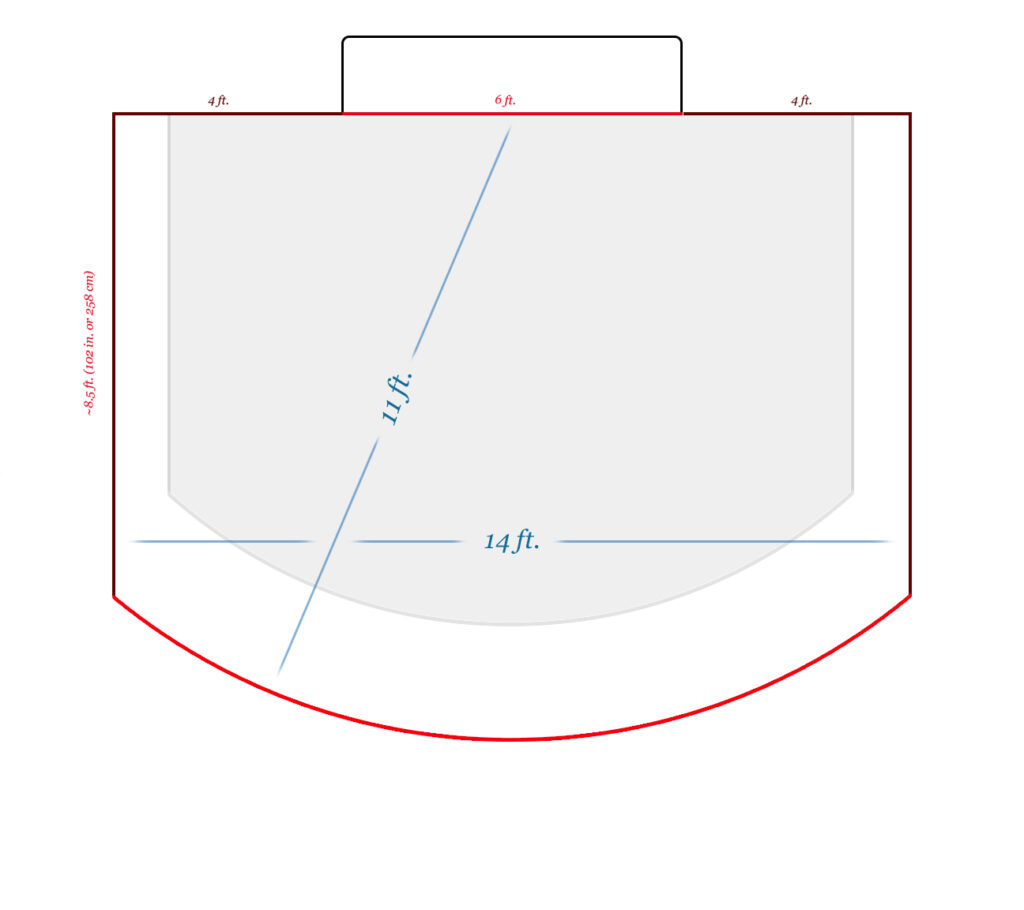
Final Thoughts
Thank you for reading through all of this, and please spend the time discussing these changes with your teammates and clubmates. We are confident that these changes will continue to make the game more competitive and more safe. Please email joe@nahardcourt.com with any questions and we will do our best to have someone respond as quickly as possible.
Cambios al reglamento 2022
Estamos felices de anunciarles que hemos desarrollado una variedad de cambios al reglamento que estamos proponiendo para la temporada 2022-2023 del Campeonato Norteamericano, esperamos recolectar retroalimentación y responder sus preguntas en el siguiente mes para poder implementar estas actualizaciones al reglamento. Este post incluye:
- Una visión general de cómo y porqué la NAH considera nuevas reglas.
- Cómo tú y tu club pueden contribuir a los cambios al reglamento propuestos.
- Una lista con la propuesta de cambios al reglamento al lado de el reglamento como actualmente existe, para fácil comparación y análisis.
- Un preámbulo para cada propuesta, que permita entender las razones y el porqué detrás de los cambios sugeridos.
El proceso del reglamento de la NAH
Nuestro objetivo es hacer los torneos de la NAH más seguros (dentro y fuera de la cancha), y una competencia más justa en relación a estrategia y habilidades. El paradigma que utilizamos para buscar cambios al reglamento es simple y se centra alrededor del objetivo principal del juego: anotar más goles que el oponente en un tiempo determinado. Una forma de probar, hacemos una variedad de preguntas para determinar qué problemas necesitan solución y si dichos problemas están relacionados a conductas de lxs jugadorxs, seguridad, estrategia o procedimiento, y finalmente, si un cambio a las reglas le sirve al objetivo principal del juego. Con ese propósito, describimos cómo este proceso será y proveemos explicaciones a cada cambio propuesto.
Razones con fines específicos
Reconocemos que las reglas de la NAH son utilizadas en la mayoría de los torneos del continente y al mismo tiempo se les hace referencia en muchos clubes durante pickup. Para ayudar con esto planeamos publicar una versión simplificada de las reglas para que sea más fácil de explicar a lxs nuevxs jugadorxs, y también para que se pueda implementar en torneos más casuales y pickup. Estas reglas tienen la intención de asegurar que cada partido desde el primer partido de los torneos Clasificatorios Regionales de la NAH hasta el último partido del torneo Norteamericano se juegue de la manera más justa posible, que el mejor equipo sea el ganador y que nadie se lastime de manera innecesaria. No es nuestra intención impedir que tu y tu club jueguen con su estilo propio, o con sus propias reglas, si creen que es más divertido o competitivo, o da lugar a más uso de sus habilidades; y son siempre bienvenidos los aportes y retroalimentación al respecto de la evolución del juego en relación con el reglamento.
Puesta a Prueba
Los últimos años han generado una gran dificultad para poner a prueba algunas de estas reglas en un ámbito de juego en torneos de alto nivel, pero a la vez ha facilitado revisar, discutir y reflexionar estas sugerencias que hacemos. Planeamos poner a prueba estas propuestas en algunos torneos próximos, y recolectar retroalimentación de los participantes. Dicho esto, la mayoría de los cambios han sido desarrollados luego de años de observar instancias finales domingos por la tarde en torneos continentales y mundiales, y hemos recibido comentarios de árbitrxs y participantes de todos los niveles.
Revocación de reglas
Sabemos que los torneos regionales clasificatorios de la NAH suelen ser el primer lugar en donde las reglas son puestas a prueba. No hay reglas permanentes, y si sucede que la propuesta de cambios a las reglas son aprobados y se incorporan al reglamento, de igual forma recolectaremos retroalimentación y será posible hacer ajustes inmediatos. Esto ha sucedido con cada actualización en el pasado, y es normal. Estamos constantemente desarrollando reglas en el comité, y ello puede significar quitar algo, si es que no funcionó.
Arbitraje
Un argumento común, luego de la aparición de las nuevas reglas propuestas es “será difícil de arbitrar”. Sentimos que este es un argumento indirecto que puede ser utilizado en contra de casi cualquier cambio a las reglas y debería ser considerado al último, pero no antes que la seguridad y competitividad. Dicho esto, estos cambios tienen la intención de hacer el arbitraje más fácil, como explicaremos más abajo. Además las reglas mismas desalientan los actos que se definen como infracción. Esta objeción, entonces, no se aplica directamente, ya que supone que los participantes continuarán realizando estos actos con la misma frecuencia con la que lo hacían antes de la modificación. La realidad es que cuando una mayoría de participantes cumplen con una regla, se torna mucho más obvio cuando alguien la infringe.
Por último, nuestra intención es reducir lo más posible las ambigüedades de interpretación de las reglas e invitamos a que todos observen otros deportes con el fin de identificar cuando lxs árbitrxs se equivocan en los ámbitos de alto nivel de cada deporte profesional, también que lxs árbitrxs no están ahí para ser perfectos, pero para manejar el juego y mantener equidad competitiva. Habrá oportunidades en el futuro para educar a jugadorxs que se interesen en convertirse en árbitrxs competentes con clínicas y contenido en línea. Si te interesa formar parte del desarrollo de estos procesos, por favor contacta a will@nahardcourt.com o joe@nahardcourt.com.
Proceso de votación – Cómo puedes involucrarte
En otros deportes, los dueños de los equipos son parte de una Junta Directiva que democráticamente vota sobre cambios a los reglamentos. Estos cambios frecuentemente son desarrollados en colaboración con representantes de lxs árbitrxs y de las asociaciones de jugadorxs de cada deporte. En nuestro caso, no existen lxs dueñxs de los equipos, pero lo que sí tenemos son 10 Representantes regionales de la NAH quienes voluntariamente coordinan cualquier tema de la NAH con los clúbes en su región. Tu clúb idealmente tiene un representante o un comité que mantiene comunicación con lx Representante Regional. Te invitamos a realizarles preguntas y participar en la votación, si crees que estos cambios propuestos afectan tu clúb. También eres libre de no participar.
La votación se llevará a cabo en un periodo de tres semanas iniciando el 3 de Junio de 2022 y terminando el 24 de Junio del mismo año. Durante las primeras dos semanas, lxs Representantes regionales se pondrán en contacto con lxs representantes del clúb para responder preguntas y recolectar su retroalimentación. Durante la última semana del periodo de votación, reuniremos los votos que lxs representantes del clúb brinden.
En esta ronda de actualizaciones, cada cambio puede ser implementado por separado, así que votaremos por cada propuesta de cambio a las reglas individualmente. Lxs representantes del clúb pueden votar Sí, Sí con cambios, No, o abstenerse a votar. En caso de que no haya respuesta o voto por parte de los representantes de clúb, se tomará como un voto de Sí a las reglas. Un formato será proveído a cada región, donde se anotarán todos los votos del clúb. Los resultados de la votación serán publicados, junto con las nuevas reglas ya que la votación haya concluido.
Te invitamos a discutir este tema primero dentro de tu clúb -de forma constructiva- de tal manera que puedas escuchar diferentes perspectivas antes de formar tu propia opinión o de escribirnos a nosotros o tu Representante regional.
Aquí proponemos algunas preguntas que puedes hacerte, o utilizarlas para discutir el tema con tu clúb:
- ¿Considero que esta regla nueva ayuda a jugar el deporte de acuerdo al objetivo del juego? Por ejemplo, ¿poner la pelota en la portería, hacer el deporte más seguro, más habilidoso, y mejorar el movimiento de la pelota y el ritmo del juego?
- Relativo a las reglas propuestas que no me gustan a mi/nosotrxs: ¿por qué?, ¿Hay alguna imparcialidad o prejuicio influenciando mi/nuestra opinión? Por ejemplo, la mayoría de las personas odiaba la regla de la obstrucción/interferencia hasta que probamos la regla por un tiempo y nos dimos cuenta en cómo mejora el ritmo del juego.¡El cambio es difícil! Así que, haciendo a un lado tus/sus opiniones personales y resistencia al cambio (Sí, ¡es difícil de hacer!), ¿es mejor para el deporte en general?
Ya que hayas discutido el tema con tu clúb, por favor primero contacta tu Representante Regional si tienes preguntas (link con la información de contacto). También puedes enviar un correo electrónico a joe@nahardcourt.com con cualquier pregunta, pero puede que tener una respuesta tome más tiempo.
Reglas que requieren votación:
Flagrancia
Hemos visto en diferentes ocasiones a través de los últimos años a lxs jugadorxs que llevan la pelota intentar pasar a toda costa a través de la defensa y terminan cayéndose o chocando, pero la persona que defiende se mantiene en pie. Actualmente, esto no se cobra por parte del árbitrx, ya que la persona que defendía no se cayó o puso el pie en el piso sino que la persona que llevaba la pelota fue quién inició el contacto y se cayó. Creemos, que una ventaja competitiva puede obtenerse de jugar de manera imprudente, y el cambio propuesto tiene la intención de desalentar éste tipo de juego, lo cual requerirá que todxs lxs jugadorxs, tanto a la ofensiva como la defensiva estén siempre en control de sus bicicletas.
Es más, ha habido instancias donde un check legal se ha hecho y lx jugadxr que recibió el check ha podido seguir rodando o sólo poner el pie en el piso, sin caerse de la bicicleta. Creemos que una ventaja competitiva puede ser obtenida de este escenario, y situaciones peligrosas son inevitables con cómo el reglamento está actualmente escrito. Aquellas personas que son increíblemente hábiles en su bicicleta puede que no reciban el mismo tipo de trato de parte de lxs árbitrxs si es que ellxs hicieran la misma jugada, y no queremos castigar habilidad.
A muchas personas en la comunidad les gustaría que el contacto intencional corporal sea eliminado completamente, y esperamos que este cambio nos lleve a un acercamiento pragmático que asegure que cualquier contacto permitido sea utilizado de forma segura o táctica.
Regla actual:
-
- …
- §10.9.2 – Una penalidad de Flagrancia se otorga cuando unx jugadxr inicia contacto físico que resulta en un choque potencialmente peligroso o el contacto es iniciado de una forma que lx árbitrx considera peligroso.
Cambio propuesto:
-
- §10.9.1 – Una penalidad de flagrancia es otorgada cuando unx jugadxr -incluyendo quien lleva la pelota- inicia contacto físico con el uso excesivo de fuerza en contra del oponente que no tiene defensa alguna, o si lx jugadxr que inicia el contacto físico de forma legal, pero abandona cualquier aplicación de fuerza táctica o estratégica, o si la persona que inicia el contacto toca el piso con el pie o se cae pero no hace que la otra persona se caiga o toque el piso con el pie.
- §10.9.3 – Una penalidad de flagrancia es otorgada cuando unx jugadxr -incluyendo quien lleva la pelota- utiliza su codo, antebrazo, o mano para iniciar contacto contra un oponente de una forma que lx árbitrx considere no tiene aplicación táctica o estratégica.
Escalamiento y acumulación de las penalidades
Piloteamos un borrador de las reglas de escalación de penalidades para el formato Squad en 2019, y fue inconveniente darle un seguimiento. Nunca fue utilizado debido a que las penalidades, tanto menores y mayores, no fueron evaluadas con la frecuencia adecuada.
Con este cambio pretendemos simplificar la aplicación y asegurar que lxs jugadorxs que comentan faltas con el fin de ganar un juego tengan consecuencias a lo largo del desarrollo del torneo.
En años pasados, hemos visto jugadorxs que reciben múltiples penalidades en los cuartos de final, semifinales o etapas eliminatorias de torneos, lo cual en otros deportes esto significa una suspensión de lx jugadxr en los partidos subsiguientes.
Replicamos lo anterior con el objetivo de desalentar el juego injusto como táctica para avanzar en una etapa eliminatoria de un torneo ó, como táctica de algún equipo.
Adicionalmente incrementaremos el tiempo de una falta menor de 30 a 45 segundos, y de 90 a 120 segundos para las faltas mayores. En nuestra opinión darle la pelota al otro equipo cuando se ha cometido una falta, no es equitativo a la mayoría de las faltas que suceden, especialmente cuando dichas faltas suceden cerca de la portería.
Con este cambio, veremos un incremento en la aplicación de penalidades que sacarán a jugadorxs de la cancha por determinada cantidad de tiempo y esperamos que lxs jugadorxs y lxs árbitrxs se sientan más cómodos con esto. Históricamente, algunos de los mejores equipos han sabido correr el tiempo de una penalidad que les resta a unx jugadxr exitosamente, y el aumento en tiempo de la penalidad y la frecuencia con la que se otorgarán dichas penalidades deberá ayudar a influir en que haya menos faltas, pero también incrementar la cantidad de goles que se aumentan durante una ventaja de este tipo, lo que creemos ser algo positivo para los torneos.
Regla actual:
- 6.1 – Severidad de la infracción y escalamiento
- …
- 6.2 – Acumulación de faltas
- 6.7 – Falta/penalidad menor
- §6.7.1 – Es una infracción que proviene de una clara oportunidad de anotar un gol que le quita una ventaja significante al equipo que ha sufrido una falta, o cualquier otra infracción especificada en §6 – §10, resulta en una penalidad de 30 segundos donde lx jugadxr que cometió la falta no podrá jugar.
- 6.8 – Faltas/penalidades mayores
- §6.8.1 – Es una infracción enlistada en §7 – §10 que lx árbitrx considere excesivamente peligrosa o de naturaleza imprudente, o si algún jugadxr ya ha sido acreedor a una falta/penalidad menor por una infracción similar, esto resultará en una penalidad de 90 segundos, donde lx jugadxr que cometió la falta no podrá jugar.
Cambio propuesto:
- 6.1 – Severidad de la infracción y escalamiento
- §6.1.1 – Es la responsabilidad del árbitrx marcar cualquier infracción enlistada en §7 – §10 y evaluar la severidad de la penalidad de tal manera que la ventaja competitiva obtenida de la infracción sea equitativa. Para determinar el nivel apropiado de la penalidad, lx árbitrx se basará en lo siguiente:
- §6.1.1.1 – El área de a cancha en la que sucedió la infracción. Considerar qué tan cerca esta unx jugadxr ofensivx a la portería del oponente, o unx jugadxr defensivx de su propia portería..
- §6.1.1.2 – Si a unx jugadxr ofensivx le han cometido una falta mientras iban solxs hacia la porteria contraria cuando ésta no tiene portero, o cuando la situación torna un 1 contra 1 contra el defensa del otro equipo dentro del área.
- §6.1.1.3 – El grado en que lx jugadxr fue fauleado basado en velocidad y fuerza, y el potencial del peligro de dicha falta.
- §6.1.1.4 – La relevancia de la infracción de acuerdo a un juego justo o del impacto que la infracción puede tener en el resultado del juego. Mientras más grande sea el efecto que la infracción tuvo en la jugada, la severidad de la penalidad también incrementa.
- §6.1.2 – Escalamiento
- §6.1.2.1 – A lx jugadxr que cometa cualquier infracción enlistada en §7, §8, §9 o §10 pero que no cause que otrx jugadxr se caiga, toque el piso con el pie, o interrumpa una oportunidad de anotar un gol de acuerdo a lo establecido en §6.1.1, se le dará un máximo de 1 un cambio de posesión de la pelota. Cada infracción después de esta será evaluada como penalidad menor o mayor, lx árbitrx puede tomar la decisión de saltarse la opción de dar un cambio de posesión de la pelota como penalidad e inmediatamente marcar una penalidad menor o mayor a su discreción.
- §6.1.2.2 – Lx jugadxr que comenta cualquier infracción contenida en §7, §8, §9 y §10 y cause que otrx jugadxr se caiga, toque el piso con el pie, o interrumpa una oportunidad de gol de acuerdo a lo establecido en §6.1.1, será otorgadx inmediatamente una penalidad menor o mayor. Todas las infracciones subsecuentes serán evaluadas como menor o mayor a discreción del árbitrx.
- 6.2 – Acumulación de Faltas
- §6.2.1 – Acumulación individual
- §6.2.1.1 – Al jugadxr que le haya sido otorgado un cambio de posesión de la pelota o una penalidad menor se le otorgará automáticamente una penalidad mayor o menor para todas las infracciones subsecuentes que cometan en ese juego, a discreción del árbitrx.
- §6.2.1.2 – Cualquier infracción que no pueda ser claramente otorgada a un jugador individualmente -como una penalidad por substitución de acuerdo a lo establecido en §7.4 – no será añadida a la cuenta individual de infracciones de unx jugadxr.
- §6.2.1.3 – Fuera por faltas
- §6.2.1.3.1 – Lx jugadxr que ha acumulado la máxima cantidad permitida de puntos por penalidades de acuerdo a lo establecido en §6.2.1.3.1.4, será considerado como fuera por faltas de ese partido.
- §6.2.1.3.1.1 – Una penalidad menor es equivalente a 1 punto.
- §6.2.1.3.1.2 – Una penalidad mayor es equivalente a 2 puntos.
- §6.2.1.3.1.3 – Una penalidad por mala conducta o antideportiva es equivalente a la cantidad máxima permitida de puntos por penalidades de acuerdo a lo establecido en §6.2.1.3.1.4.
- §6.2.1.3.1.4 – La cantidad máxima total permitida de puntos por penalidades para cada jugadxr es de 3 (tres) en juegos de 25 minutos o menos, y 4 (cuatro) en juegos mayores a 25 minutos.
- §6.2.1.3.2 – Lx jugadxr que está fuera por faltas deberá abandonar la cancha y no serán permitidos volver a jugar en dicho juego.
- §6.2.1.3.2.1 – El juego será reiniciado de acuerdo a lo establecido en §6.7 y §6.8, y el equipo de lx jugadxr que está fuera deberá continuar jugando con sólo 2 (dos) jugadorxs dentro de la cancha, y hasta que el tiempo de la penalidad adquirida (mayor o menor) haya corrido, un tercer jugador del mismo equipo podrá reingresar a la cancha.
- §6.2.1.3.2.2 – En formato 3v3, el juego se continuará con sólo los dos jugadores restantes del equipo que ha sido penalizado.
- §6.2.2 – Acumulación en torneo
- §6.2.2.1 – Prohibición de jugar
- §6.2.2.1.1 – Lx jugadxr que ha estado fuera por faltas en dos juegos de acuerdo a lo establecido en §6.2.1.4, no le será permitido jugar en el siguiente partido que su equipo tenga.
- §6.2.2.1.2 – Por cada vez que unx jugadxr esté fuera por faltas otra vez, no le será permitido jugar en el siguiente partido que su equipo tenga.
- §6.2.2.2 – Si varixs jugadorxs están fuera por faltas y deben cumplir una suspensión del juego, se garantiza a un equipo un mínimo de 3 jugadorxs elegibles en cada partido o un máximo de 2 jugadorxs no elegibles en cada partido, si el equipo tiene 4 o más jugadorxs.
- §6.2.2.2.1 – El orden en que se cumplen las suspensiones de juego las determina el orden en que se otorgaron las penalidades en el partido anterior. §6.2.2.2.2 – Un equipo de squad con solo tres jugadorxs elegibles en su lista debe jugar con dos jugadorxs hasta que se hayan cumplido todas las suspensiones de juego. Por ejemplo, si un equipo tiene cinco jugadorxs y tres de ellxs están fuera por faltas en un mismo partido, dos de esxs jugadorxs no podrán jugar el próximo partido, y uno sí. El tercer jugadxr que juegue el primer partido no podrá jugar el partido consecuente (el orden de jugadores que pueden jugar será determinado por el orden en que se otorgaron las penalidades).
- §6.2.2.3 – Registrios y Apelaciones
- §6.2.2.3.1 – Lxs organizadorxs del torneo mantendrán registros de las faltas individuales y lx árbitrx informará a los equipos antes de los partidos si sus penalidades pueden escalar al punto de no poder continuar jugando en el torneo por otra penalidad de “fuera por falta”.
- §6.2.2.3.2 – Un equipo puede apelar formalmente a lxs organizadorxs del torneo si cree que el total de penalidades es incorrecto, o si desea disputar una penalidad otorgada por lx árbitrx en ese partido. Lxs organizadorxs consultarán con lxs árbitrxs, jueces de línea, y capitanxs de ambos equipos para informar al equipo de su decisión final. §6.2.2.3.2.1 – Las apelaciones sólo se pueden hacer después de un partido y no durante.
- §6.2.2.3.2.2 – Si unx jugadxr intenta eludir su “prohibición de jugar” ya no será elegible para jugar en ningún partido posterior en ese torneo. §6.2.2.3.2.3 – Si es posible, sugerimos revisar el video del juego para evaluar faltas y penales..
- 6.7 – Penalidad Menor
§6.7.1 – Se otorga cuando se comete una falta que impide una clara oportunidad de gol o le quita una ventaja significativa del equipo al que se comete la falta, o cualquier otra acción específica descrita en §6 – §10, la penalidad serán 45 segundos de ventaja donde el jugador que cometió la falta no puede jugar.
- 6.8 – Penalidad Mayor
§6.8.1 – Cualquier falta enumerada en §7 – §10 que lx árbitrx considere excesivamente peligrosa o imprudente, o si un jugadxr ya recibió una penalidad menor por una falta similar, resulta en una ventaja de 120 segundos donde lx jugadxr que cometió la falta no puede jugar. …
Conducta Problemática
Ha habido un aumento en el número de casos en los que lxs participantes de torneos no se sienten comodxs con otrx jugadxr que juega en ese torneo. NAH siente que es necesario tener un proceso que elimine la obligación de lxs organizadorxs del torneo de confrontar a los individuos y navegar conversaciones increíblemente difíciles. Nuestra propuesta es implementar un método anónimo y democrático para resolver estas situaciones.
Cambio propuesto:
- §2.1.4 – Si un participante cree que el comportamiento de otrx jugadxr registrado viola el Código de Comportamiento de Torneos de NAH, o es problematicx, esx participante o su club o representante regional puede acercarse a lxs organizadorxs del torneo para solicitar se revise la elegibilidad de esx jugadxr para jugar en el torneo. §2.1.4.1 – Lxs organizadorxs están obligados a informar a cada capitanx del equipo el motivo de la revisión de elegibilidad.
- §2.1.4.2 – Lxs capitanxs de los equipos vemitirán su voto en privado a lxs organizadorxs y los resultados serán anónimos.
- §2.1.4.3 – Lxs capitanxs de los equipos votarán Sí para remover lx jugadxr del torneo, No para dejar que lx jugadxr siga jugando o podrán Abstenerse para que no se cuente su voto.
- §2.1.4.3 – La mayoría de los votos de Sí o No determina si esx participante puede participar en el torneo y lxs organizadorxs informarán a esx jugadxr de la decisión de lxs demás participantes independientemente del resultado..
- 7.2 – Comportamiento antideportivo …
- §7.2.1.5 – Cualquier comportamiento que viole el Código de Comportamiento de Torneos de NAH.
Penales
Algo que hemos querido agregar durante muchos años es“penales” para las faltas cometidas durante las oportunidades de gol. La propuesta es que el “penal” reemplace la penalidad de “punto otorgado” que ya tenemos. El “tiro de penal” es un procedimiento bastante sencillo: después de que una falta impida una oportunidad de gol, cualquier jugadxr de ese equipo puede empezar con la pelota en la mitad de la cancha y deberá tirar antes de que la pelota entre el área frente a la portería. Habría dos variaciones de penales, una con porterx y otra sin porterx, dependiendo del contexto en el que se cometiera la falta. Sentimos que esto puede rectificar mejor cualquier ventaja que se ha perdido en la oportunidad de gol y amplía la aplicación de la regla anterior de “punto otorgado.”
Regla actual:
- 6.10 – Punto otorgado
- 6.10.1 – Una falta que afecta a unx jugadxr en posesión de la pelota y que se acerca a una portería sin portero deberá resultar en una penalidad otorgada por lx árbitrx de acuerdo con lo establecido en §1.1.9.3 y se concederá un punto al equipo que perdió esa clara oportunidad de gol.
- §6.10.1.1 – Si la falta cometida al jugadxr en posesión justifica un cambio de posesión de la pelota o una penalidad menor, lo anterior no se hará y el equipo infractor reinicia el juego con posesión según lo establecido en §4.2 como si se hubiera anotado un gol normal ya que será un punto otorgado para el equipo al que se le hizo la falta.
- §6.10.1.2 – Si la falta cometida sobre al jugadxr en posesión de la pelota justifica una penalidad mayor o penalidad de conducta personal antideportiva, el equipo infractor no pierde la posesión y reinicia el juego según lo establecido en §4.2, sin embargo, lx jugadxr que cometió la falta deberá cumplir la sanción de “ventaja de jugadxr” al reinicio del juego.
Cambio propuesto
- §6.10.1 – Una falta que le impida a unx jugadxr en posesión de la pelota que se acercaba a una portería sin porterx o defendida por un oponente en el área de portería, resultará en una penalidad otorgada por lx árbitrx de acuerdo a lo establecido en §1.1.9.3 y de acuerdo con lo mencionado en §4.2 se realizará un tiro penal con el tiempo del juego pausado antes de que se reinicie el juego.
- §6.10.1.1 – Procedimiento de Tiro Penal Penalty Shot Procedure
- §6.10.1.1.1 – Cualquier jugadxr del equipo al que se le cometió la falta puede optar hacer el tiro penal. Any player from the team that was fouled may elect to take the Penalty Shot.
- §6.10.1.1.2 – Lx jugadxr comenzará con la pelota en la línea de media cancha y podrá comenzar a acercarsehacia la portería después de que lx árbitrx lo indique al hacer sonar su silbato.
- §6.10.1.1.3 – Lx jugadxr debe hacer una línea razonablemente directa hacia la portería, sin regresar hacia su propia portería, y deberá tirar antes de que la pelota entre en el área de la portería. .
- §6.10.1.1.4 – Lx árbitrx pitará para declarar el tiro penal invalido si lx jugadxr entra en el área de portería antes de haber tirado o no avanza hacia la portería, y de acuerdo con lo establecido en §4.2 el juego se reiniciará con el equipo que recibió la falta manteniendo la posesión de la pelota.
- §6.10.1.1.5 – El equipo que cometió la falta tendrá unx jugadxr en el área de portería para defende el tiro penal sólo si había un defensa dentro del área de portería cuando se cometió la falta.
- §6.10.1.1.6 – Si lx jugadxr anota el tiro, se otorgará un gol a su equipo. Si lx jugadxr falla el tiro, no se otorgará el gol a su equipo.
- §6.10.1.2 – Si se otorga una penalidad menor por la falta cometida y lx jugadxr realiza con éxito el tiro penal, se considerará terminado el tiro penal de acuerdo con lo establecido en §6.7.2.2 y el equipo podrá reiniciar el juego con lxs 3 jugadorxs en la cancha. Si lx jugadxr falla el tiro penal, de acuerdo con §6.5.1 el juego se reiniciará con una penalidad de “ventaja de jugadxr.”
- §6.10.1.3 – Si se otorgó una penalidad mayor por la falta cometida, se reiniciará el juego y el equipo que cometió la falta sólo tendrá 2 jugadorxs en la cancha según de acuerdo con lo establecido en §6.5.1, independientemente de si se realizó el tiro penal o no.
Hachazos y Enganchadas.
A través de los años hemos visto un decremento en la cantidad de fisicalidad dentro del juego y un incremento en la utilización de jugadas que no requieren un hachazo del bastón/mallet como estrategia principal de defensa teniendo o no en cuenta dónde está la pelota en relación al defensorx. Han habido instancias donde jugadorxs son jaladxs de sus bicis, manos, brazos y piernas son golpeadxs por bastones/mallets en jugadas normales con la pelota. También ha habido golpes en la cabeza por enganchar o tirar un hachazo al bastón/mallet del oponente de tal manera que a veces la única opción para esx jugadxr seguir jugando es levantar el bastón/mallet por encima de su cabeza. Luego también hemos visto bastones/mallets que atraviesan las ruedas de otrxs a alta velocidad, bastones/mallets que entran al espacio del manubrio de otrxs jugadorxs cuando ellxs no están lo suficientemente cerca de la pelota para intentar ganar control sobre ella, y en algunas otras instancias bastante peligrosas hemos visto choques que son el resultado de jugadorexs intentando desenganchar sus bastones/mallets.
Ocasionalmente es benéfico mirar otros deportes, y en la mayoria de los deportes con pelota, el acto de impedir unx jugadxr sosteniendo o jalando su cuerpo/camiseta/equipo es casi universalmente ilegal, y considerado (usualmente) juego sucio. Otros deportes con palos tampoco permiten la “pelea de espadas”: por ejemplo el hockey no permite el enganche o hachazo del palo de otrx jugadxr, y lacrosse solo permite el impedimento del palo si ese jugadxr tiene posesión de la pelota, ¿Por que? Porque el objetivo de este deporte con bastón es desarrollar la habilidad de mandar una pelota al arco, no estar jugando a las espadas o hachazos. Esto sirve como precedente en contraste con el status quo del bici polo. Que en espiritu, jugadorxs que se han comunicado con nosotxs sienten que enganchar un bastón/mallet y la prolongación de tal genera un disturbio en cómo fluye el juego, y al mismo tiempo genera situaciones peligrosas que son innecesarias como mencionamos anteriormente.
La combinación de los cambios que presentamos eliminará la mayoría de jugadas del bastón/mallet de este estilo, y nuestras intenciones son mantener la pelota en movimiento y tener un juego más seguro. La intención NO es eliminar jugadas de bastón/mallet contra el oponente que se hacen por debajo del manubrio cuando se está peleando el control de la pelota; si no, esperamos que estos cambios alienten maniobras defensivas distintas para mantener el partido moviéndose ágilmente y asegurar que estas tácticas sean utilizadas de manera segura y con un nivel de habilidad mayor para ejecutar el juego.
Seguiría siendo legal que unx jugadxr haga un toque entre bastón/mallets una o dos veces, hacer contacto accidental por uno o dos segundos solamente y siempre y cuando se intente poseer control de la pelota. Asimismo, si unx jugadxr utiliza la táctica de enganchar/hachar el bastón/mallet del oponente como única maniobra contra el jugador que posee la pelota para prevenir que sigan avanzando resultará en un penal atrasado.
Finalmente, hemos actualizado la regla del High stick para prohibir todo tipo de acción por arriba de la estatura del manubrio cuando se está próximo a un oponente. Esperamos que motive a jugadorxs a tener un poco de conciencia espacial antes de hacer tiros a la portería, pasar la pelota o intentar un scoop.
Regla actual:
-
- §7.3.4 – Se otorgará una penalidad de interferencia de mallet/bastón cuando unx jugadxr utilice su bastón/mallet para entrar en contacto con el bastón/mallet, cuerpo o bicicleta de un oponente que no está en posesión de la pelota.
- §9.2 – High Sticking – Bastón/mallet arriba
- …
- §9.4 – Hooking- Enganchar el bastón/mallet
-
- §9.4.1 – Se otorgará una penalidad de hooking o enganchamiento cuando unx jugadxr enganche su bastón/mallet en la bicicleta o el cuerpo de lx jugadxr oponente.
Cambio propuesto:
-
- …
- §7.3.4 – Se otorgará una penalidad de interferencia de mallet/bastón cuando unx jugadxr utilice su mallet/bastón para impedir el movimiento del bastón/mallet, cuerpo o bicicleta del oponente.
- §7.3.4.1 – Unx jugadxr solo puede impedir el movimiento del bastón/mallet del oponente si este tiene posesión de la pelota o si ambxs jugadorxs están lo suficiente cerca para jugar la pelota con sus bastones/mallets, y lx jugadxr que impidió el movimiento del mallet/bastón del oponente deberá intentar ganar la posesión de la pelota en la misma interacción/el mismo encuentro.
- §7.3.4.1.1 – Si la pelota sale de la proximidad de lx jugadxr antes de que este tenga la oportunidad de intentar ganar la posesión, no se marcará la falta.
- §7.3.4.2 – Los ejemplos del impedimento de bastón/malet incluyen pero no se limitan a:
- Múlitples movimientos como golpear (machetazos), tocar, o levantar el bastón/mallet del oponente.
- Si se pasa más tiempo inmovilizando u ocupando el espacio del bastón/mallet del oponente que intentando obtener la posesión de la pelota durante una interacción.
- §9.4.2 y §9.1.1 regulan aún más el juego del bastón/mallet definiendo “hooking” (inmovilizar el bastón/mallet del oponente enganchando la cabeza del bastón/mallet) y “slashing” (machetazos), respectivamente).
- §9.2 – Bastón/mallet arriba – High Sticking
- §9.2.3 – Se otorgará una penalidad de bastón/mallet arriba cuando unx jugadxr intente iniciar contacto o impedir el movimiento del bastón/mallet del oponente por encima de la altura del manubrio de cualquiera de lxs jugadorxs.
-
- §9.2.4 – Se otorgará una penalidad menor o mayor según lo determine lx árbitrx, a cualquier jugadxr que golpee el cuerpo de otrx jugadxr con el bastón/mallet arriba.
- §9.4 – Enganchar el bastón/mallet – Hooking
-
- §9.4.1 – Se otorgará una penalidad de enganchar cuando unx jugadxr enganche su bastón/mallet en el bastón/mallet, la bicicleta o el cuerpo del oponente.
- §9.4.1.1 – Si unx jugadxr mueve su bastón/mallet de una manera que cause que su propio bastón/mallet se enganche, no se marcará una falta.
Cambios al reglamento que serán implementados sin votación:
Reinicio del juego
Hacer una cuenta regresiva de 10 segundos, obtener el reconocimiento del equipo que anotó gol y volver a contar desde 10, ha demostrado ser tedioso y molesto para algunxs jugadorxs. Queremos intentar hacer una cuenta regresiva de 15 segundos. Si los equipos usan esto estratégicamente, tenemos un método diferente que proponer. Sin embargo, estamos segurxs de que este método será suficiente para permitir que los equipos regresen a su lado de la cancha, tomen sus posiciones, y se preparen para reanudar el juego.
Cambio propuesto
- …
- §4.2.3 – Después de una pausa, los equipos tienen 15 segundos para regresar a su respectiva mitad de la cancha y prepararse para reanudar el juego.
- §4.2.4– Lx árbitrx indicará que el juego se reiniciará anunciando “El juego se reiniciará en 15 segundos” y comenzará a contar de 15 a 0. El juego comienzará y el cronómetro iniciará, si es que no está corriendo ya, porque la pelota o unx jugadxr del equipo en posesión de la pelota cruzó la línea de media cancha.
- §4.2.4.1 – Si el equipo en posesión de la pelota no inicia una jugada dentro de los primeros 15 segundos después de que ambos equipos confirmaron estar listos, el tiempo comenzará a correr, lx árbitrx dirá “jueguen” y el equipo sin posesión podrá cruzar la línea de media cancha.
- §4.2.4.2 – Para indicar que están listxs para comenzar a jugar, lxs jugadorxs del equipo sin posesión de la pelota deben cruzar la línea de media cancha hacia su mitad.
- §4.2.4.3 – Si el equipo sin posesión de la pelota no regresa a su mitad, o permanece en la mitad de su oponente hasta el último momento posible, se otorgará una penalidad menor de retraso del juego.
Dinámica de la banca
Actualmente, solo permitimos sustituciones de jugadores durante el juego en formatos de “squad” y “bench”. Hemos recibido comentarios de que muchas canchas dificultan cambiar jugadores debido a la ubicación o mecanismo de la puerta que usan los equipos para entrar y salir de la cancha. Tenemos una pequeña adición para facilitar las sustituciones en esas canchas.
Adición propuesta:
- …
- §4.9.3 – Si alguna cancha en un torneo tiene entradas que son irregulares, difíciles de operar o que no son apropiadas para hacer sustituciones de jugadorxs durante el juego, lxs organizadorxs del torneo informarán a los equipos que las sustituciones solo se pueden hacer durante las interrupciones del juego y deberán ocurrir durante el tiempo asignado a los equipos antes reiniciar al juego, según lo establecido en §4.2.
El ancho de manubrio
Algunxs jugadorxs que miden más de ~ 6’3” (1.91 m) legítimamente necesitan manubrios más anchos para un control más ergonómico de su bicicleta. Si sucede que lxs jugadorxs comienzan a abusar de este cambio de regla, se reevaluará revertirla. Estamos aumentando el ancho permitido de 660 mm a 700 mm.
Cambio propuesto:
- §2.4.2 – Los orificios laterales de los manubrios deberán tener tapones o estar cubiertos y no pueden medir más de 13.75 pulgadas (13.75″ o 350 mm) desde el centro de la potencia hacia cada lado.
Bajar el pie – Dabbing
En las reglas actuales, ha sido ilegal realizar el movimiento común de bloquear tiros bajando la mano con el puño cerrado al suelo con el bastón/mallet perpendicular al suelo. Esto claramente no se asemeja a la esencia de la regla contra bajar el pie. Además, hay ciertas acciones que unx jugadxr puede realizar en las que no tiene el control de su bicicleta y ya no puede manejar ni pedalear. Esta actualización intenta aclarar qué es y qué no es considerado “bajar el pie,” así como qué constituye una penalidad de retraso del juego al proteger la pelota con la bicicleta.
Regla actual
- 8.1 – Bajar el pie – Dabbing
- §8.1.1 – La falta de Bajar el pie ocurre cuando el cuerpo de unx jugadxr toca algo que no sea su propio equipo o el lado vertical de la cancha, con excepciones limitadas. El cuerpo de lx jugadxr no puede tocar el suelo, las porterías o los cuerpos/equipo de otrxs jugadorxs con el objetivo de mantener el equilibrio.
- §8.1.2 – Unx jugadxr que baja el pie debe ir a tocar con su bastón/mallet el muro/tabla a mitad de cancha (de cualquier lado). Esta acción se conoce como “ir a tocar”.
- §8.1.2.1 – Unx jugadxr que baja el pie se considera fuera del juego y no puede interferir con la jugada usando su bicicleta, cuerpo o bastón/mallet para impedir que el oponente intente recuperar la pelota o desafíe a lx porterx.
- §8.1.2.2 – Unx jugadxr que baja el pie se considera fuera del juego y no puede ser parte del juego. Cualquier contacto físico, uso de bastón/mallet, contacto con la bicicleta o pantalla contra unx jugadxr que bajó el pie será sancionado con una falta por interferencia.
- §8.1.2.3 – Unx jugadxr que baja el pie tiene una cantidad de tiempo razonable para retirarse del área de juego donde bajar el pie occurió. Sin embargo, lx árbitrx puede marcar una falta si lxl jugadxr que bajó el pie interfiere con la jugada de manera que resulte en una ventaja para su equipo.
- §8.1.2.4 – Si unx jugadxr que baja el pie bloquea un tiro que hubiera sido gol en su propia portería, lx árbitrx puede otorgar un punto al equipo de lx jugadxr que tiró..
- §8.1.3 – Se considera bajar el pie cuando unx jugadxr se apoya con cualquier parte de su cuerpo en la portería o la agarra con la mano para mantener estabilidad.
- §8.1.3.1 – Lx árbitrx le hará una advertencia verbal a lx jugadxr que baje el pie. Lx juez de línea puede también señalar que algún jugadxr bajó el pie según lo establecido en § 1.3.6.4. Lx jugadxr que bajo el pie deberá ir a tocar.
- §8.1.3.2 – Lx árbitrx puede otorgar una penalidad en los casos de agarre o apoyo excesivo en la portería.
- §7.1.1 – Se otorgará una penalidad de retraso del juego en los siguientes escenarios:
- …
- §7.1.1.2 – Unx jugadxr retiene la pelota con su bicicleta mientras se recarga contra el muro/tabla, evitando que otrxs jugadorxs manipulen la pelota.
- …
Cambio propuesto:
- 8.1 – Bajar el pie – Dabbing
- §8.1.1 – Bajar el pie ocurre cuando el cuerpo de unx jugadxr toca algo que no sea su propio equipo o el lado vertical de la cancha, con excepciones limitadas.
- §8.1.1.1 – El cuerpo de lx jugadxr no puede tocar el suelo, las porterías o los cuerpos o equipo (bici y bastón/mallet) de otrxs jugadorxs para mantener el equilibrio, y unx jugadxr debe estar en control de su bici en todo momento.
- §8.1.1.2 – Unx jugadxr puede tocar el suelo con la mano por un momento para bloquear la pelota o recuperar el bastón/mallet que se le cayó, pero no puede usar la mano para mantener el equilibrio sobre la bicicleta.
- §8.1.2 – Unx jugadxr que baja el pie debe ir a tocar con su bastón/mallet el muro/tabla a mitad de cancha (de cualquier lado). Esta acción se conoce como “ir a tocar”.
- …
- §8.1.2.3 – Unx jugadxr que baja el pie tiene una cantidad razonable de tiempo para retirarse del área de juego. Sin embargo, lx árbitrx puede otorgar como mínimo una penalidad menor si lx jugadxr que baja el pie interfiere con la jugada de manera que resulte en una ventaja para su equipo.
- §8.1.2.4 – Si unx jugadxr que baja el pie bloquea un tiro que hubiera sido gol en su propia portería, lx árbitrx puede otorgar un tiro penal al equipo de lx jugadxr que tiró. Bajar el pie en la portería se define en §8.1.3.
- §8.1.3 – Se considera bajar el pie cuando unx jugadxr se apoya con cualquier parte de su cuerpo en la portería o la agarra con la mano para mantener estabilidad.
- §8.1.3.1 – Lx árbitrx le hará una advertencia verbal verbal a lx jugadxr que baja el pie. Lx juez de línea también puede señalar que se cometió una falta de bajar el pie según lo establecido en § 1.3.6.4. Lx jugadxr que cometió la falta deberá ir a tocar.
- §8.1.3.2 – Lx árbitrx puede otorgar una penalidad en casos de apoyo excesivo en la portería, o si unx jugadxr no se retira del juego inmediatamente.
- §7.1.1 – Se otorgará una penalidad de retraso del juego en los siguientes escenarios:
- …
- §7.1.1.2 – Unx jugadxr evita que otrxs jugadorxs jueguen la pelota atrapando la pelota con su bicicleta mientras se recarga contra el muro/tabla, o protegiendo la pelota con su bicicleta, cuerpo o bastón/mallet mientras está fuera del juego por bajar el pie.
- …
El tamaño del área frente a la portería
El área frente a la portería se hará 2 pies (61 cm) más grande. Aquí hay un diagrama del área anterior en gris.
-
- …
- §2.2.5 – El área frente a la portería mide 2.7432 m (9’) y tiene forma de un semicírculo a partir del centro y la línea de gol y se extiende 91.5 cm (3’) hacia el exterior de cada poste. Puedes consultar el diagrama en § 2. La línea de gol se extiende a todo lo ancho de la cancha.
Reflexiones finales
Gracias por leer el documento completo y dedicarle tiempo a discutir estos cambios con sus compañerxs de equipo y de club. Estamos segurxs de que estos cambios seguirán haciendo que el juego sea más competitivo y más seguro. Si tienes alguna pregunta, puedes enviar un correo electrónico a joe@nahardcourt.com y haremos todo lo posible para responder lo más rápido posible.
